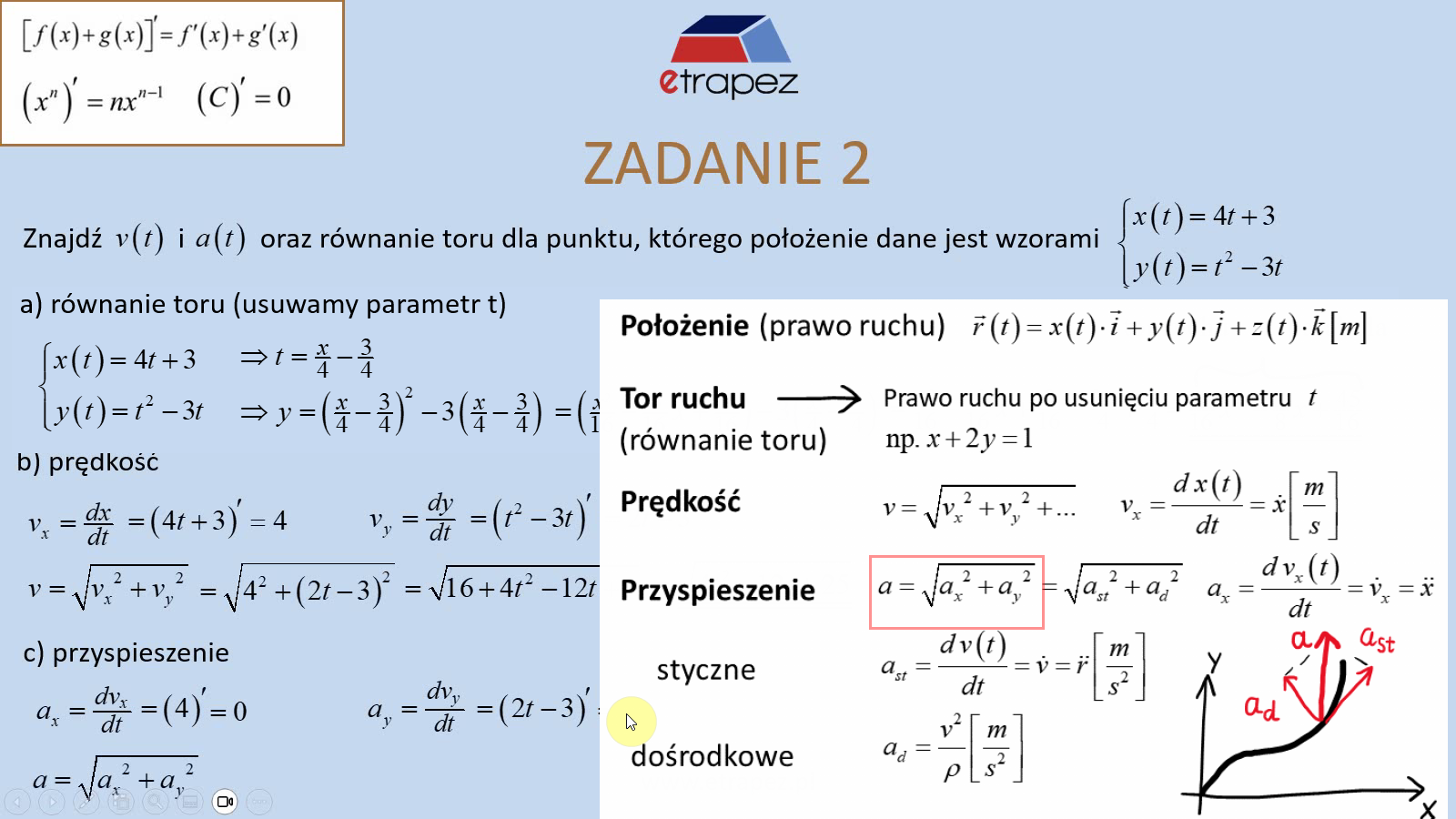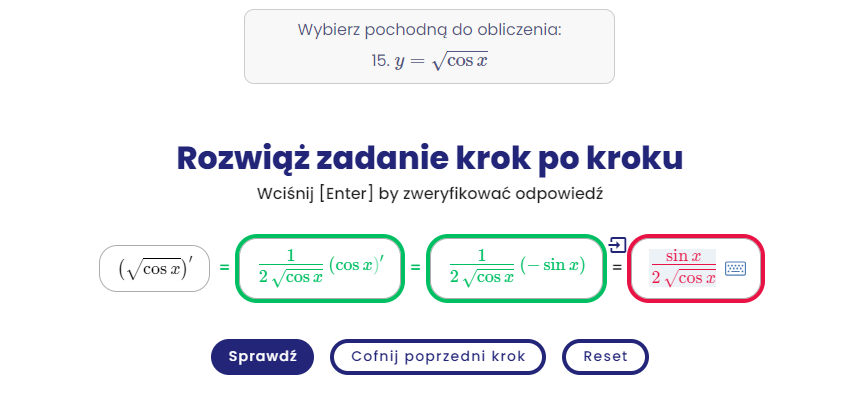
Kalkulator pochodnych (NIEAKTUALNY). Zapraszam do NOWEJ wersji!
Krystian Karczyński
Założyciel i szef serwisu eTrapez.
Magister matematyki Politechniki Poznańskiej. Korepetytor matematyki z wieloletnim stażem. Twórca pierwszych Kursów eTrapez, które zdobyły ogromną popularność wśród studentów w całej Polsce.
Mieszka w Szczecinie. Lubi spacery po lesie, plażowanie i kajaki.
Ogłoszenie
Niestety, po ponad 12 latach od udostępnienia przeze mnie darmowego kalkulatora pochodnych, musiałem go „wyłączyć”.
Kalkulator był prostym „widgetem” strony WolframAlpha. Jakiś czas temu Wolframalpha zmienił swoją politykę odnośnie widgetów. Między innymi: przestały one obliczać „na miejscu”, tylko przerzucają użytkownika na stronę WolframAlpha .
Przepraszam za kłopot wszystkich dotychczasowych użytkowników Kalkulatora Do Pochodnych. Przez długie lata bił on rekordy popularności jeśli chodzi o liczbę odwiedzających i zapytań.
Nowy kalkulator pochodnych
Zapraszam też do nowego kalkulatora pochodnych, stworzonego już przeze mnie w technologii Open Source. Dostęp do niego (i do innych interaktywnych narzędzi) uzyskać możecie w ramach subskrypcji za jedyne 5,99 zł / miesiąc na stronie:
Pozdrawiam i powodzenia!
Krystian Karczyński
Szukasz korepetycji z matematyki na poziomie studiów lub szkoły średniej? A może potrzebujesz kursu, który przygotuje Cię do matury?
Jesteśmy ekipą eTrapez. Uczymy matematyki w sposób jasny, prosty i bardzo dokładny - trafimy nawet do najbardziej opornego na wiedzę.
Stworzyliśmy tłumaczone zrozumiałym językiem Kursy video do pobrania na komputer, tablet czy telefon. Włączasz nagranie, oglądasz i słuchasz, jak na korepetycjach. O dowolnej porze dnia i nocy.











Mam problem z pochodą funkcji f(x)= arcsin(sqrt(x-1)) we wzorze na pochodną jest x^2 a w kalkulatorze wynik wychodzi bez kwadratu 🙁 nie wiem co robię źle.
Rozwiązałem ten przykład krok po kroku, czy coś pomogłem?
Dzień dobry mam problem z policzeniem tych pochodnych :Niech y = f(x) = cos 2x, g(x) = e^((1/3)*x)a) oblicz g'(3)b) oblicz (f(x)g(x))’c) oblicz (f(x)/g(x))’
a)
g’\left( x \right) = {\left( {{e^{{\textstyle{1 \over 3}}x}}} \right)^\prime } = {e^{{\textstyle{1 \over 3}}x}} \cdot {\left( {\frac{1}{3}x} \right)^\prime } = \frac{1}{3}{e^{{\textstyle{1 \over 3}}x}}
g’\left( 3 \right) = \frac{1}{3}{e^{{{\frac{1}{3}}} \cdot 3}} = \frac{1}{3}e = \frac{e}{3}
b)
f\left( x \right)g\left( x \right) = \cos 2x \cdot {e^{{\textstyle{1 \over 3}}x}} = {e^{{\textstyle{1 \over 3}}x}}\cos 2x
{\left[ {f\left( x \right)g\left( x \right)} \right]^\prime } = {\left( {{e^{{\textstyle{1 \over 3}}x}}\cos 2x} \right)^\prime } = {\left( {{e^{{\textstyle{1 \over 3}}x}}} \right)^\prime }\cos 2x + {e^{{\textstyle{1 \over 3}}x}}{\left( {\cos 2x} \right)^\prime } =
= {e^{{\textstyle{1 \over 3}}x}}{\left( {\frac{1}{3}x} \right)^\prime }\cos 2x + {e^{{\textstyle{1 \over 3}}x}}\left( { – \sin 2x} \right) \cdot {\left( {2x} \right)^\prime } = \frac{1}{3}{e^{{\textstyle{1 \over 3}}x}}\cos 2x – 2{e^{{\textstyle{1 \over 3}}x}}\sin 2x =
= {e^{{\textstyle{1 \over 3}}x}}\left( {\frac{1}{3}\cos 2x – 2\sin 2x} \right)
spoko opcja czasami korzystamy Pozdro
Dzień dobry, jak wprowadzic pierwiastek w kalkulator aby obejmował całe wyrażenie a nie tylko daną część?
Dzień dobry.Nwm jak policzyć pochodną f(x) =sin(2 do x).Wię piszę tutaj
Dzień dobry, pójdzie tak:
Witam, polecam moją darmową Lekcję do liczenia pochodnej z definicji 🙂
A co przykładu, poleci tak:
W naszym przypadku .
.
Mamy więc:
Sprawdzamy prawdziwość tego wyniku korzystając ze wzorów:
Czyli wszystko gra 🙂
Witam,
mam problem z rozwiązaniem takiego zadania:
Oblicz z definicji pochodną f(x)= 1/(5x+6) w punkcie x0. Poprawność sprawdź z wzorów na pochodne.
Z góry dziękuję za pomoc.
Panie Krystianie, nie do końca wiem jak obliczyć pochodną z funkcji (2x^6-16x^3)/(x^3-2)^2. Mógłby Pan mi prosze pomóc? 🙂
Pochodna z .
.
Na początku mamy tutaj dzielenie dwóch funkcji, więc zaczynamy od zastosowania wzoru:
No tu wyjdzie ostatecznie:
x^2+e^x/x-lnx czy pomoze ktoś ?
Jeżeli dobrze odczytałem zapis, to pójdzie tak:
WitamMam problem z pochodna x^x jak to obliczyc?
Myślę, że ten filmik będzie baaardzo pomocny i wszystko wyjaśniający (chociaż przykład jest lekko inny) 🙂
W Pani przypadku wyjdzie ostatecznie:
Pójdzie tak:
Cześć!Mam problem z pochodną 6x(x^2+1)^2 mógłbys wytłumaczyc krok po kroku?
Tak, zapraszam:
Witam serdecznie. Mam problem z pochodną f(x)= 3/((1-x^2)(1-2x^3)). Kalkulator pokazuje odpowiedź: 6x(-5x^3+3x+1)/(mianownik^2). A w moich obliczeniach wszystko się zgadza oprócz tego, że mam -6x. Ktoś wie co się stało z tym minusem? Proszę o odpowiedź
W pewnym momencie można wyciagnąć -2x przed nawias:
Witam. Mam problem z policzeniem pochodnej f(x)=ln(x)log_2(x)
Witam, nie rozumiem dlaczego pochodna z funkcji f(x)=e^2x+e^-x wychodzi e^2-e^-x a nie 2e^2x-e^-xBardzo proszę o odp
Witammam policzyć pochodne i nie potrafię sobie z nimi poradzić:

 mogę prosić o pomoc
mogę prosić o pomoc
dzień dobry,czy ktoś może wie w jaki sposób krok po kroku obliczyć pochodną poniższej funkcji? Będę wdzięczna za pomoc 🙂
Będę wdzięczna za pomoc 🙂
Dzień dobry,zasanowiła mnie jedna rzecz. Chcąc sprawdzić wynik pochodnej (-8cos(x)sin(x))’ znalałzam Pana kalkulator i inny. wg Pana kalkulatora wynik to (-8cos(2x)), a to wyszło w innym (8(sinx)^2 – 8(cosx)^2) – i ja też otrzymałam taki wynik. Mogę prosić o pomoc?To całe zadanie jaki muszę obliczyć: -8cos(x)sin(x)+(e^(x^(1/2))(1- (1/x^(1/2))) /(4x))”Podzieliłam” je na 2 zgodnie z właściwościami pochodnych – [f(x)+g(x)]’ = f'(x)+g'(x)
„wg Pana kalkulatora wynik to (-8cos(2x)), a to wyszło w innym (8(sinx)^2 – 8(cosx)^2) – i ja też otrzymałam taki wynik.”
Pani Kasiu – oba wyniki są poprawne 🙂 Policzyła Pani wszystko prawidłowo.
Kalkulator zamieszczony na Blogu po prostu dodatkowo dokonał jeszcze jedne przekształcenie, wykorzystując rozpisanie wzoru ze szkoły średniej (jak pamiętamy, tam były jego 3 wersje)
ze szkoły średniej (jak pamiętamy, tam były jego 3 wersje)
Rozpisując Pani wynik:
mam problem z pochodną funkcji :
oczywiście polecenie policz pochodne
1.
Stosuję wzór
2.
Stosuję wzory: oraz
oraz 
Stosuję wzory oraz
oraz 
w kalkulatorze wychodzą bzdury gdy liczy się pochodną pierwiastków:np po wpisaniu (x^2)^-2 czyli (pochodna to oczywiście 1) wychodzi
(pochodna to oczywiście 1) wychodzi
Tutaj akurat kalkulator dobrze policzył pochodną 🙂
Wpisana formuła „(x^2)^-2” (potęga (-2) ) nie oznacza pierwiastka, tylko inna potęgę, a mianowicie:
 – minus w potędze odwraca podstawę 🙂
– minus w potędze odwraca podstawę 🙂
Aby wprowadzić pierwiastek, trzeba wziąć potęgę ułamkową, czyli powinien Pan wpisać „”(x^2)^(1/2)”
Wtedy pochodna:
Witam Panie Krzysztofie,czy mógłby mi Pan pomóc z obliczeniem pochodnej:
Stosuję wzory dla pochodnej ułamku:
Dzień dobry, chciałem zwrócić uwagę na błąd, gdy w pochodnej funkcji sqrt(3^3 -2) wynikiem jest ((3^x)log(3))/(2(sqrt(3x-2))), gdzie w miejscu log powinno być ln.Pozdrawiam
Witam, w ostatniej lekcji z kursu pochodnych robił Pan przykład x/lnx, Moje pytanie brzmi skąd w wykresie 2 pochodnej wziął się punkt 1. wklejam juz policzoną 2 pochodną
Dzień dobry Panie Krystianie!Czy mógłby mi Pan pomóc w obliczeniu pochodnej z: *
*  ?
?
Wiadomo, że pochodna liczby stałej wynosi zero:
Obliczymy:
Stąd mamy, że
Liczba stała nie zależy od x. Obliczymy ją:
Wtedy funkcja
i jej pochodna
(wg wzoru dla funkcji złożonej: )
)
wynosi:
Witam, potrzebuję obliczyć pierwszą pochodną funkcji. Jak to zrobić?i(x) = 3e^2x *lnx
Stosuję wzory: (gdzie C – stała) oraz
(gdzie C – stała) oraz  , a także
, a także
Witam,nie wiem czy kalkulator dobrze liczy ale wychodzi że (ln(x))’ = 1/x i to jest dobrze ale wpisując ln(2x) podaje wynik też 1/x czy to jest aby dobrze? Czy nie powinno być 2/x ?Proszę o szybką odpowiedź.
Tutaj wynik jest poprawny, pochodna
Bierze się to z tego, że jest to złożenie dwóch funkcji – nie ma Pan samego „x” w logarytmie tylko coś więcej. Przy liczeniu takich pochodnych, najpierw robimy pochodną tej funkcji „zewnętrznej” i domnażamy do niej pochodną funkcji w środku, tej „wewnętrznej”.
Ogólnie na wzorach to idzie tak:
Przy naszych danych to pójdzie tak: , gdzie za ten
, gdzie za ten  biorę funkcję wewnętrzną.
biorę funkcję wewnętrzną.
Stąd ostatecznie:
Witam mógłby mi ktoś pomóc obliczyć pochodną funkcji y=
Stosuję wzór:
jak obliczyć pochodna funkcjiy= 4x^1/3 * (5 + 2*4^3^x)/x^2 + 1
Stosuję wzory:
Witam, jak obliczyć pochodną funkcji f(x)= e^(2x+1)/(x-2)
Witam, czy mógłby mi Pan wytłumaczyć jak rozwiązać taką pochodną:f(x)=xsinxlnx ?z góry dziękuje i pozdrawiam 🙂
Znany jest wzór dla pochodnej iloczynu:
Spróbujemy otrzymać wzór dla iloczynu trzech czynników:
Wtedy:
(2x-1)^4=8(2x-1)^3 dlaczego tak????
Jak to obliczyć ? f(x)=
f(x)=x^2*(x-2)^2Wytłumaczysz mi jak to policzyłeś, trochę inaczej mam rozpisane z zajęć i się pogubiłam…? Z góry dziękuję 🙂
Stosuję wzór:
Można było inaczej:
Wtedy:
f(x)=ln
czy moge zapisac w postaci ???
???
1) f(x)= 2) f(x)=
2) f(x)= 3) f(x)=ln(
3) f(x)=ln( )
)
odp do f(x)= to
to  ???
???
Stosuję wzór na pochodne funkcji złożonej:
f(x)= ???
???
Tutaj jest do policzenia pochodna funkcji złożonej, czyli argumentem nie jest sam „x” tylko coś więcej, nie ma po prostu tylko
tylko  .
.  .
.
Postępujemy jak zawsze w takich przypadkach, czyli: pochodna tego co „na zewnątrz” pomnożyć razy pochodna funkcji wewnętrznej (coś więcej niż sam „x”), czyli jakby
Stąd:
Tak, „pierwiastek” można wpisać na dwa sposoby
1) wpisując: \sqrt(…) , np \sqrt(2x) oznacza
2) wpisując potęgę ułamkową , tzn. (…)^(1/2) , np (x)^(1/2) oznacza
jak rozwiazac:1) f(x)= 2) f(x)=
2) f(x)= z góry bardzo dziękuje!
z góry bardzo dziękuje!
1.
Skorzystam ze wzoru:
czy mógłby ktoś mi pomóc z rozwiązaniem pochodnej: (x^2)/(2-x) ?
Kalkulator wylicza to jako: [-(x-4)x]/[(x-2)^2]
Ja wyliczam już czwarty raz i za każdym wychodzi mi taki sam wynik [(4-x)x]/[(2-x)^2], niestety inny niż kalkulatora 🙁
proszę o pomoc!
Oba wyniki są poprawne i oba są identyczne 🙂
Po prostu ten z kalkulatora wyliczony „wyciągnął” jeszcze minusy z każdego z wyrażeń.
Przekształcę więc je tak, że na górze wciągnę go z powrotem, a na dole jakby go wyciągnę jeszcze raz (bo podniesiony do kwadratu się zredukował). Proszę popatrzeć:
\displaystyle \frac{{-(x-4)x}}{{{{{(x-2)}}^{2}}}}=\frac{{(-x+4)x}}{{{{{\left[ {-(-x+2)} \right]}}^{2}}}}=\frac{{(4-x)x}}{{{{{(-1)}}^{2}}{{{(2-x)}}^{2}}}}=\frac{{(4-x)x}}{{{{{(2-x)}}^{2}}}}
No i wyszedł Pani wynik 🙂
jeju, rzeczywiście, ale głupi błąd! 😛
Bardzo dziękuje, juz rozumiem 😉
Witam, nie rozumiem dlaczego pochodna ln2x^2 to y'(x) = (2 log(2 x))/x
Bardzo pomocny kalkulator pochodnych funkcji, przydatny szczególnie do sprawdzania wyników.
Witam 🙂 Dlaczego pochodna z e^(2^x)=2^x*e^(2^x)*log2?
Tutaj jest do policzenia pochodna funkcji złozonej, czyli argumentem nie jest sam „x” tylko coś więcej, nie ma po prostu tylko
tylko  .
. 
Postępujemy jak zawsze w takich przypadkach, czyli: pochodna tego co „na zewnątrz” pomnożyć razy pochodna funkcji wewnętrznej (coś więcej niż sam „x”), czyli jakby
Stąd: , gdyż wprost z wzorku
, gdyż wprost z wzorku  .
.
Witam. Mam problem z zadaniem: f(x1,x2)=1/2ln(5×1^2-2×2). Jak mogę narysować krzywe w punktach 0, 1 i 2? Wytyczenie pochodnej i całki również by się przydało…
Dzień dobry, bardzo prosiłabym o pomóc z przykładem [((arctgX^2)^3)/((e^3)*x+3^x)]^(arctg(x^4-ln(2x^8+1) Czyli iloraz w tym kwadratowym nawiasie podnosimy do potęgi i z tego wszystkiego policzyć pochodną…wychodzą mi kosmiczne rozwiazania…Z góry dziękuję.
Panie Krystianie,
może jest mi Pan w stanie wytłumaczyć dlaczego pochodna z -arctg|x| ma pochodną -x/(|x^3|+|x|), a nie po prostu -1/(1+x^2)?
Byłabym bardzo wdzięczna za pomoc 🙂
Pani Kasiu, gdyby do policzenia byłaby pochodna po prostu z \displaystyle -arctgxto byłaby równa rzeczywiście \displaystyle -\frac{1}{{1+{{x}^{2}}}}
Jednak tutaj do policzenia jest pochodna \displaystyle -arctg\left| x \right|, czyli argumentem nie jest sam „x” tylko coś więcej – moduł z „x”.
Postępujemy jak zawsze w takich przypadkach, czyli: pochodna tego co „na zewnątrz” pomnożyć razy pochodna funkcji wewnętrznej (coś więcej niż sam „x”), czyli jakby \displaystyle \left( {-arctg\Delta } \right)’\cdot \Delta ’
Pytanie, ile wynosi pochodna modułu z x ?
Rozpisując moduł, wiem, że:

Czyli odpowiednio pochodna byłby równa 1 lub -1.. Jednak potrzebuję pochodnej w ogólnym przypadku (nie na przedziałach).
Dlatego uznaje się, że pochodna modułu to (warto zapamiętać ten wzór):
\displaystyle \left( {\left| x \right|} \right)’=\frac{x}{{\left| x \right|}}
Można sobie rozpisać na odpowiednich przedziałach i faktycznie wyjdzie 1 lub -1 😉
Mając wszystko, liczę:
\displaystyle \left( {-arctg\left| x \right|} \right)’=-\frac{1}{{1+{{{\left| x \right|}}^{2}}}}\cdot \left( {\left| x \right|} \right)’=-\frac{1}{{1+{{{\left| x \right|}}^{2}}}}\cdot \frac{x}{{\left| x \right|}}=-\frac{x}{{\left| x \right|+{{{\left| x \right|}}^{3}}}}
Mam wielką prośbę. Nie moge poradzić sobie z monotonicznością tej funkcji x^3/(x^2+-x-2) będę ogromnie wdzięczny za odpowiedz. Pozdrawiam 🙂
x^3/(x^2-x-2) wyzej jest mały bląd
Dana jest funkcja .
.
Zaczynamy od wyznaczenia dziedziny funkcji.
Zatem
Przechodzimy do wyznaczania monotoniczności funkcji . W tym celu obliczymy jej pochodną i sprawdzimy, kiedy jest dodatnia, a kiedy ujemna.
. W tym celu obliczymy jej pochodną i sprawdzimy, kiedy jest dodatnia, a kiedy ujemna.
Zbadamy teraz, kiedy pochodna przyjmuje wartości większe lub równe , a kiedy mniejsze lub równe
, a kiedy mniejsze lub równe  .
.
Pochodna przyjmuje wartości większe lub równe dla
dla  oraz dla
oraz dla  .
.  dla
dla  .
.
Pochodna przyjmuje wartości mniejsze lub równe
Należy pamiętać o założeniach dziedziny: .
.
Zatem podana funkcja jest rosnąca w przedziałach ,
,  oraz malejąca w przedziałach
oraz malejąca w przedziałach  ,
,  ,
,  .
.
Witam! Mam taką funkcję :
f(x) = (2x-x^2)^(2/3). Jak obliczyć pochodną takiej funkcji?
By obliczyć pochodną z funkcji \displaystyle {{(2x-{{x}^{2}})}^{{\frac{2}{3}}}} stosuję wzór
\displaystyle \left( {{{x}^{n}}} \right)’=n\cdot {{x}^{{n-1}}}, gdzie jak zauważam, mam coś więcej niż sam „x”, mam dodatkową funkcję (zwaną funkcją wewnętrzną). W taki przypadku obliczoną pochodną przemnażamy przez pochodną funkcji wewnętrznej, czyli mam jakby:
\displaystyle \left( {{{\Delta }^{n}}} \right)’=n\cdot {{\Delta }^{{n-1}}}\cdot \Delta ’
Mam więc:
\displaystyle \left( {{{{(2x-{{x}^{2}})}}^{{\frac{2}{3}}}}} \right)’=\frac{2}{3}{{(2x-{{x}^{2}})}^{{\frac{2}{3}-1}}}\cdot (2x-{{x}^{2}})’=\frac{2}{3}{{(2x-{{x}^{2}})}^{{-\frac{1}{3}}}}\cdot (2-2x)=\frac{{2\cdot (2-2x)}}{{3\sqrt[3]{{2x-{{x}^{2}}}}}}[/latex]
Witam wszystkich. I proszę o pomoc.
Mam problem z taką pochodną
f(x)=[1-sin(2x)]/[2x^4+7x^2-3] Zatrzymuje się w pewnym momencie i nie wiem co dalej. Kalkulator do pochodnych stworzonego przez Pana Krystiana błędnie odczytuje ostatnia część 7x^2-3 zamiast zrobić wszystko w potędze obejmuje liczbę trzy od reszty za potęga. Proszę o pomoc
To nie chodzi Panu o pochodną funkcji \displaystyle \frac{{1-sin(2x)}}{{2{{x}^{4}}+7{{x}^{2}}-3}}?
A może \displaystyle \frac{{1-sin(2x)}}{{2{{x}^{4}}+{{7}^{{{{x}^{2}}-3}}}}}, czy jeszcze inaczej? Proszę może gdzieś nawias () wstawić dodatkowo, to co ma być ujęte w potędze, bo nie do końca rozumiem o co chodzi z
„część 7x^2-3 zamiast zrobić wszystko w potędze obejmuje liczbę trzy od reszty za potęga”.
Pozdrawiam
Witam, mam problem z pochodną: e^(3x+2)*((x^6)+4). Nie mam pojęcia jak to rozwiązać, bardzo proszę o pomoc…
Wykorzystuję tutaj wzór na iloczyn dwóch funkcji
\displaystyle \left( {f\cdot g} \right)’=f’\cdot g+f\cdot g’
Muszę również pamiętać o tym, że licząc pochodną funkcji złożonej, muszę domnożyć jeszcze razy pochodna funkcji wewnętrznej, tego „coś więcej niż sam x” . to znaczy
\displaystyle \left( {{{e}^{\Delta }}} \right)’={{e}^{\Delta }}\cdot \Delta ’
No to rozwiązując przykład:
\displaystyle \begin{matrix}\left( {{{e}^{{3x+2}}}\cdot ({{x}^{6}}+4)} \right)’=\left( {{{e}^{{3x+2}}}} \right)’\cdot ({{x}^{6}}+4)+{{e}^{{3x+2}}}\cdot ({{x}^{6}}+4)’= \\ {{e}^{{3x+2}}}\cdot (3x+2)’\cdot ({{x}^{6}}+4)+{{e}^{{3x+2}}}\cdot (6{{x}^{5}}+0)={{e}^{{3x+2}}}\cdot 3\cdot ({{x}^{6}}+4)+{{e}^{{3x+2}}}\cdot 6{{x}^{5}}= \\ 3{{e}^{{3x+2}}}\cdot \left( {{{x}^{6}}+4+2{{x}^{5}}} \right)=3{{e}^{{3x+2}}}\cdot \left( {{{x}^{6}}+2{{x}^{5}}+4} \right)\end{matrix}
Pochodna z: cos^2\pierwiastek z x +sin^2\pierwiastek z x.
Czyli chodzi o pochodną funkcji \displaystyle {{cos }^{2}}\sqrt{x}+{{sin }^{2}}\sqrt{x}?
No to liczę:
\displaystyle \begin{matrix}\left( {{{{cos }}^{2}}\sqrt{x}+{{{sin }}^{2}}\sqrt{x}} \right)’=2cos \sqrt{x}\cdot \left( {cos \sqrt{x}} \right)’+2sin \sqrt{x}\cdot \left( {sin \sqrt{x}} \right)’= \\ 2cos \sqrt{x}\cdot (-sin \sqrt{x})\cdot \left( {\sqrt{x}} \right)’+2sin \sqrt{x}\cdot cos \sqrt{x}\cdot \left( {\sqrt{x}} \right)’= \\-2sin \sqrt{x}cos \sqrt{x}\cdot \frac{1}{{2\sqrt{x}}}+2sin \sqrt{x}\cdot cos \sqrt{x}\cdot \frac{1}{{2\sqrt{x}}}=0\end{matrix}
Dzień dobry panie Krystianie, czy mogłabym liczyć na pomoc w policzeniu pochodnej e^-x^2
Z góry dziękuję i pozdrawiam
Pochodna funkcji \displaystyle y={{e}^{-}}^{{{{x}^{2}}}}
Jest to funkcja złożona, licząc jej pochodną, liczę pochodną funkcji „zewnętrznej”, czyli e^(coś) i muszę domnożyć jeszcze ją razy pochodna funkcji wewnętrznej, tego „coś więcej niż sam x” . to znaczy
\displaystyle \left( {{{e}^{\Delta }}} \right)’={{e}^{\Delta }}\cdot \Delta ’
Mam:
\displaystyle \left( {{{e}^{-}}^{{{{x}^{2}}}}} \right)’={{e}^{-}}^{{{{x}^{2}}}}\cdot \left( {-{{x}^{2}}} \right)’={{e}^{-}}^{{{{x}^{2}}}}\cdot \left( {-2x} \right)=-2x{{e}^{-}}^{{{{x}^{2}}}}
Witam a jak to rozwiązać ? :/ (x+1)(x+4)
f(x)=(x+1)(x+4)
Pochodną tego można policzyć tak na prawdę na dwa sposoby:
I SPOSÓB – z pochodnej iloczynu \displaystyle \left( {f\cdot g} \right)’=f’\cdot g+f\cdot g’
\displaystyle \begin{matrix}\left( {\text{(x+1)(x+4)}} \right)\text{ }!!’!!\text{ =(x+1) }!!’!!\text{ }\cdot \text{(x+4)}+\text{(x+1)}\cdot \text{(x+4) }!!’!!\text{ =(1+0)}\cdot \text{(x+4)}+\text{(x+1)}\cdot \text{(1+0)=}\text{x+4+x+1=2x+5}\end{matrix}
II SPOSÓB – przemnożyć przez siebie te dwa nawiasy (bez problemu mogę, gdyż w jednym jak i w drugim jest wielomian) i potem policzyć pochodną otrzymanego wielomianu korzystając z wzoru \displaystyle \left( {{{x}^{n}}} \right)’=n\cdot {{x}^{{n-1}}}
\displaystyle \text{(x+1)(x+4)}={{x}^{2}}+4x+x+4={{x}^{2}}+5x+4
\displaystyle \left( {{{x}^{2}}+5x+4} \right)’=\left( {{{x}^{2}}} \right)’+\left( {5x} \right)’+\left( 4 \right)’=2x+5\cdot 1+0=2x+5
Witam Panie Krystianie. Czy w wyznaczaniu pochodnych takie cos jak: e^pi , traktujemy jako liczbę czyli wynik to zero czy w inny sposób?
Dziękuje za odpowiedz
Pozdrawiam
Tak dokładnie, traktujemy to wyrażenie jako liczbę (nie ma Pani tutaj żadnej zmiennej „x”, tylko same stałe), więc pochodna tego to zero 🙂
Czy ktoś by mógł mi pomóc w rozwiązaniu tych pochodnych?
y=e^(1/cosx)
y=a/2(e^(x/a)+e^(-(x/a)))
y=arcsin(e^4x )
y=e^√(7x^2 )
y=log_7cos√(1+x)
Przykład pierwszy: \displaystyle y={{e}^{{\frac{1}{{cos x}}}}}
Jest to funkcja złożona, liczę pochodną funkcji „zewnętrznej”, czyli e^(coś) i muszę domnożyć jeszcze ją razy pochodna funkcji wewnętrznej, tego „coś więcej niż sam x” . To znaczy
\displaystyle \left( {{{e}^{\Delta }}} \right)’={{e}^{\Delta }}\cdot \Delta ’
Mam:
\displaystyle \left( {{{e}^{{\frac{1}{{cos x}}}}}} \right)’={{e}^{{\frac{1}{{cos x}}}}}\cdot \left( {\frac{1}{{cos x}}} \right)’
Pochodną \displaystyle \left( {\frac{1}{{cos x}}} \right)’można policzyć np z wzoru na iloraz dwóch funkcji
\displaystyle \left( {\frac{f}{g}} \right)’=\frac{{f’\cdot g-f\cdot g’}}{{{{g}^{2}}}}
{e^{\frac{1}{{\cos x}}}}\frac{{1′ \cdot \cos x – 1 \cdot {{\left( {\cos x} \right)}^\prime }}}{{{{\cos }^2}x}} = {e^{\frac{1}{{\cos x}}}}\frac{{ – \left( { – \sin x} \right)}}{{{{\cos }^2}x}} = \frac{{{e^{\frac{1}{{\cos x}}}}\sin x}}{{{{\cos }^2}x}}
Przykład drugi: \displaystyle y=\frac{a}{2}({{e}^{{^{{\frac{x}{a}}}}}}+{{e}^{{-\frac{x}{a}}}})
Jak rozumiem, liczbę „a” traktuję jako pewną stałą?
No to liczę pochodną, stosując wzór: \displaystyle \left( {{{e}^{\Delta }}} \right)’={{e}^{\Delta }}\cdot \Delta ’
\displaystyle y’=\left( {\frac{a}{2}({{e}^{{^{{\frac{x}{a}}}}}}+{{e}^{{-\frac{x}{a}}}})} \right)’=\frac{a}{2}\left( {{{e}^{{^{{\frac{x}{a}}}}}}+{{e}^{{-\frac{x}{a}}}}} \right)’=\frac{a}{2}\left[ {\left( {{{e}^{{^{{\frac{x}{a}}}}}}} \right)’+\left( {{{e}^{{-\frac{x}{a}}}}} \right)’} \right]=
\displaystyle \frac{a}{2}\left[ {{{e}^{{^{{\frac{x}{a}}}}}}\left( {\frac{x}{a}} \right)’+{{e}^{{^{{-\frac{x}{a}}}}}}\left( {-\frac{x}{a}} \right)’} \right]=\frac{a}{2}\left[ {{{e}^{{^{{\frac{x}{a}}}}}}\cdot \frac{1}{a}\cdot 1+{{e}^{{^{{-\frac{x}{a}}}}}}\cdot \left( {-\frac{1}{a}} \right)\cdot 1} \right]=
\displaystyle \frac{a}{2}\cdot \frac{1}{a}\left( {{{e}^{{^{{\frac{x}{a}}}}}}-{{e}^{{^{{-\frac{x}{a}}}}}}} \right)=\frac{1}{2}\left( {{{e}^{{^{{\frac{x}{a}}}}}}-{{e}^{{^{{-\frac{x}{a}}}}}}} \right)
Można ewentualnie trochę przekształcić wynik i otrzymać:
\displaystyle \frac{1}{2}\left( {{{e}^{{^{{\frac{x}{a}}}}}}-{{e}^{{^{{-\frac{x}{a}}}}}}} \right)=\frac{1}{2}\left( {{{e}^{{^{{\frac{{2x}}{a}-\frac{x}{a}}}}}}-{{e}^{{^{{-\frac{x}{a}}}}}}} \right)=\frac{1}{2}{{e}^{{^{{-\frac{x}{a}}}}}}\left( {{{e}^{{^{{\frac{{2x}}{a}}}}}}-1} \right)
Przykład trzeci: chodzi o \displaystyle y=arcsin({{e}^{4}}\cdot x) czy może \displaystyle y=arcsin({{e}^{{4x}}})
Pierwszy przypadek:
\displaystyle \left( {arcsin({{e}^{4}}\cdot x)} \right)’=\frac{1}{{\sqrt{{1-{{{({{e}^{4}}\cdot x)}}^{2}}}}}}\cdot \left( {{{e}^{4}}\cdot x} \right)’=\frac{1}{{\sqrt{{1-{{{({{e}^{4}}\cdot x)}}^{2}}}}}}\cdot {{e}^{4}}\left( x \right)’=\frac{{{{e}^{4}}}}{{\sqrt{{1-{{e}^{8}}{{x}^{2}}}}}}
Drugi przypadek:
\displaystyle \left( {arcsin({{e}^{{4x}}})} \right)’=\frac{1}{{\sqrt{{1-{{{({{e}^{{4x}}})}}^{2}}}}}}\cdot \left( {{{e}^{{4x}}}} \right)’=\frac{1}{{\sqrt{{1-{{e}^{{8x}}}}}}}\cdot {{e}^{{4x}}}\left( {4x} \right)’=\frac{{4{{e}^{{4x}}}}}{{\sqrt{{1-{{e}^{{8x}}}}}}}
Przykład czwarty: \displaystyle y={{e}^{{\sqrt{{7{{x}^{2}}}}}}}
Mamy tutaj złożenie kilku funkcji, dlatego korzystam z następujących wzorów:
\displaystyle \left( {{{e}^{\Delta }}} \right)’={{e}^{\Delta }}\cdot \Delta ’
\displaystyle \left( {\sqrt{\Delta }} \right)’=\frac{1}{{2\sqrt{\Delta }}}\cdot \Delta ’
gdzie znaczek \displaystyle \Delta oznacza po prostu „coś więcej niż sam x”.
\displaystyle y’=\left( {{{e}^{{\sqrt{{7{{x}^{2}}}}}}}} \right)’={{e}^{{\sqrt{{7{{x}^{2}}}}}}}\cdot \left( {\sqrt{{7{{x}^{2}}}}} \right)’={{e}^{{\sqrt{{7{{x}^{2}}}}}}}\cdot \frac{1}{{2\sqrt{{7{{x}^{2}}}}}}\cdot \left( {7{{x}^{2}}} \right)’=\frac{{{{e}^{{\sqrt{{7{{x}^{2}}}}}}}}}{{2\sqrt{{7{{x}^{2}}}}}}\cdot 7\cdot 2x=\frac{{7x{{e}^{{\sqrt{{7{{x}^{2}}}}}}}}}{{\sqrt{{7{{x}^{2}}}}}}
Przykład piąty: \displaystyle lo{{g}_{7}}cos\sqrt{{1+x}}
Tym razem mamy pochodną logarytmu, gdzie pod wyrażeniem logarytmowanym jest coś więcej niż sam x (oznaczam to przez \displaystyle \Delta ). Funkcja jest złożona i to kilkukrotnie. Dlatego stosuję na początku wzór :
\displaystyle \left( {{{{log }}_{a}}\Delta } \right)’=\frac{1}{{\Delta ln a}}\cdot \Delta’
Obliczając kolejne pochodne, Mam więc:
\displaystyle \left( {{{{log }}_{7}}cos \sqrt{{1+x}}} \right)’=\frac{1}{{cos \sqrt{{1+x}}\cdot ln 7}}\cdot \left( {cos \sqrt{{1+x}}} \right)’=
\displaystyle \frac{1}{{cos \sqrt{{1+x}}\cdot ln 7}}\cdot \left( {-sin \sqrt{{1+x}}} \right)\cdot \left( {\sqrt{{1+x}}} \right)’=
\displaystyle -\frac{{sin \sqrt{{1+x}}}}{{cos \sqrt{{1+x}}\cdot ln 7}}\cdot \frac{1}{{2\sqrt{{1+x}}}}\cdot \left( {1+x} \right)’=
\displaystyle -tg\sqrt{{1+x}}\cdot \frac{1}{{2\cdot ln 7\cdot \sqrt{{1+x}}}}\cdot \left( {0+1} \right)=-\frac{{tg\sqrt{{1+x}}}}{{2ln 7\cdot \sqrt{{1+x}}}}
dlaczego pochodna z -x/(x-1)^2 wychodzi y'(x) = (x+1)/(x-1)^3
Stosuję tutaj wzór na pochodną ilorazu dwóch funkcji, czyli
\displaystyle \left( {\frac{f}{g}} \right)’=\frac{{f’\cdot g-f\cdot g’}}{{{{g}^{2}}}}
No to rozpisując przykład:
\displaystyle \left( {\frac{{-x}}{{{{{(x-1)}}^{2}}}}} \right)’=\frac{{\left( {-x} \right)’\cdot {{{(x-1)}}^{2}}-\left( {-x} \right)\cdot \left[ {{{{(x-1)}}^{2}}} \right]’}}{{{{{\left[ {{{{(x-1)}}^{2}}} \right]}}^{2}}}}=\frac{{\left( {-1} \right)\cdot {{{(x-1)}}^{2}}+x\cdot 2\cdot (x-1)\cdot (x-1)’}}{{{{{(x-1)}}^{4}}}}=\frac{{-{{{(x-1)}}^{2}}+2x\cdot (x-1)\cdot 1}}{{{{{(x-1)}}^{4}}}}=\frac{{(x-1)\cdot \left[ {-(x-1)+2x} \right]}}{{{{{(x-1)}}^{4}}}}=\frac{{-x+1+2x}}{{{{{(x-1)}}^{3}}}}=\frac{{x+1}}{{{{{(x-1)}}^{3}}}}
Cześć
Mam prośbę w sprawie rozwiązania równania różniczkowego metodą analityczną (krok po kroku):
y`-0,5y=xe^(2x)
z góry dziękuję
Chciałabym dowiedzieć się jak wyszedł ten wynik:y'(x) = 3 x^2 cos(1-x^2)+2 x^4 sin(1-x^2) z funkcji x^3cos(x^2-1)
Tutaj by obliczyć pochodną podanej funkcji, wykorzystuję wzór na pochodną iloczynu dwóch funkcji:
\displaystyle \left( {f\cdot g} \right)’=f’\cdot g+f\cdot g’
Jedną z niech jest \displaystyle f={{x}^{3}}, drugą zaś \displaystyle g=cos ({{x}^{2}}-1), która jest funkcją złożoną.
No to liczymy pochodną:
\displaystyle \left( {{{x}^{3}}cos ({{x}^{2}}-1)} \right)’=\left( {{{x}^{3}}} \right)’\cdot \left( {cos ({{x}^{2}}-1)} \right)+\left( {{{x}^{3}}} \right)\cdot \left( {cos ({{x}^{2}}-1)} \right)’=3{{x}^{2}}\cdot cos ({{x}^{2}}-1)+{{x}^{3}}\cdot \left( {-sin ({{x}^{2}}-1)} \right)\cdot ({{x}^{2}}-1)’=3{{x}^{2}}\cdot cos ({{x}^{2}}-1)-{{x}^{3}}\cdot sin ({{x}^{2}}-1)\cdot 2x=3{{x}^{2}}\cdot cos ({{x}^{2}}-1)-2{{x}^{4}}\cdot sin ({{x}^{2}}-1)
Wynik jest jednak odrobinę inny od tego wskazanego w WolframAlpha
http://www.wolframalpha.com/input/?i=%28x%5E3*cos%28x%5E2-1%29%29%27
Widać, że wyrażenie w nawiasie – wielomian jest przedstawiony „odwrotnie”, jakby z minusem, co oczywiście można zrobić, czyli \displaystyle cos ({{x}^{2}}-1)=cos (-(1-{{x}^{2}}))lub też \displaystyle sin ({{x}^{2}}-1)=sin (-(1-{{x}^{2}}))
I w tym miejscu korzystając z własności funkcji trygonometrycznych kąta ujemnego:
\displaystyle \begin{matrix} cos (-\alpha )=cos (\alpha )sin (-\alpha )=-sin (\alpha )\end{matrix}
Otrzymuję wynik zgodny z tym wskazanym z kalkulatorze:
\displaystyle 3{{x}^{2}}\cdot cos ({{x}^{2}}-1)-2{{x}^{4}}\cdot sin ({{x}^{2}}-1)=3{{x}^{2}}\cdot cos (-(-{{x}^{2}}+1))-2{{x}^{4}}\cdot sin (-(-{{x}^{2}}+1))=3{{x}^{2}}\cdot cos (1-{{x}^{2}})-2{{x}^{4}}\cdot (-sin (1-{{x}^{2}}))=3{{x}^{2}}\cdot cos (1-{{x}^{2}})+2{{x}^{4}}\cdot sin (1-{{x}^{2}})
Witam. Dostałem na egzaminie dwa przykłady, skorzystałem z kalkulatora on je oczywiście obliczył ale ja nadal nie wiem skąd wziął się wynik, oto one :
1) (niestety nie wiem do czego dąży x bo się zamazało ale chyba do nieskończoności) lim(lm(1+4x^2))/x
2) (też x chyba dąży do nieskończoności) lim(1-e^2x)/tg(x)
Pozdrawiam Karol
Dzień dobry.
Pewnie pisze pod złym postem, forum, czy nie wiem jak to nazwać. Jednakże mam zadanie które nie bardzo wiem, jak rozwiązać. Liczę na Pańską pomoc 🙂
Zad.: Dowieść,że dla xcR prawdziwa jest nierówność:
a) 2xarctgx > ln(1+x^2)
b) |arctgx – arctgy| <= |x-y|
Dodam jeszcze, iż wiem, że jest to związane z Twierdzeniem Lagrange'a ale nawet z tą wiedzą nic mądrego mi nie wychodzi 🙁
Dzień dobry!
Muszę policzyć pierwszą i drugą pochodną z y=lnx/√x wygląda niewinnie ale jest niezwykle uciążliwa. Bardzo proszę o pomoc Panie Krystianie
Należy skorzystać ze wzoru na dzielenie
Dostaniemy
I druga pochodna
Witam. Mam problem z obliczeniem pochodnej dla f(x) = arcsin√1-x/1+x. Całe wyrażenie dzielenia jest pod pierwiastkiem.
y=e^2x + x^2 + cos(4x^3-6)
przy e jest do potęgi 2x.
potrzebuje pomocy
A dlaczego pochodna z ctgx+x=-ctg^2x ????????????
chcialbym zapytac jako co traktujemy a/t przy funkcji cos t/a
Mam pytanie
dlaczego √x(1-2x^2) ma pochodną 1-10x^2/2√x ? Prosze o wytłumaczenie. Z gódy dziękuje 🙂
Pomoże ktoś mam do obliczenia 2 pochodne : (sinx / sinx-cosx) i pierwiastek z 5 tgx -2ctgx. Z góry dziękuje za odpowiedź 🙂
Dzień dobry, jak policzyć pochodną (x-1)^3(x-2) krok po kroku i dlaczego wyznacza się 3 przed nawias? Nie rozumiem tego. Byłabym wdzięczna za wytłumaczenie. Pozdrawiam
pochodna sin(x^x) – krok po kroku, proszę !
Mam pytanie, ile wynosi pochodna z \sqrt(2x-sinx(cos(x))^3)
Mama pytanie, jak bedzie wygladala pochodna z arcsin(2x-1)? Czy po tym jak „trafi” pod pierwiastek to (2x-1)^2 nalezy rozwinac jak rownanie kwadratowe?
Pójdzie tak:
{{\left( arcsin \left( 2x-1 \right) \right)}^{\prime }}=\frac{1}{\sqrt{1-{{\left( 2x-1 \right)}^{2}}}}{{\left( 2x-1 \right)}^{\prime }}=\frac{1}{\sqrt{1-\left( 4{{x}^{2}}-4x+1 \right)}}\cdot 2=
=\frac{2}{\sqrt{1-4{{x}^{2}}+4x-1}}=\frac{2}{\sqrt{-4{{x}^{2}}+4x}}=\frac{2}{\sqrt{4\left( -{{x}^{2}}+x \right)}}=\frac{2}{\sqrt{4}\sqrt{x-{{x}^{2}}}}=
=\frac{2}{2\sqrt{x-{{x}^{2}}}}=\frac{1}{\sqrt{x-{{x}^{2}}}}
Polecam: Kurs Pochodnych
Hej:)
Mam problem z policzeniem pochodnych II rzędu.
Przykład wygląda tak:
f(x,y)= 7- 4x/y – 2x^4y^3
Byłabym wdzięczna za pomoc:)
Pozdrawiam.
Hej. To pójdzie tak:
f\left( x,y \right)=7-\frac{4x}{y}-2{{x}^{4}}{{y}^{3}}
Pochodne cząstkowe I-go rzędu:
\frac{\partial f}{\partial x}=\frac{\partial }{\partial x}\left( 7-\frac{4x}{y}-2{{x}^{4}}{{y}^{3}} \right)=\frac{\partial }{\partial x}\left( 7 \right)-\frac{\partial }{\partial x}\left( \frac{4x}{y} \right)-\frac{\partial }{\partial x}\left( 2{{x}^{4}}{{y}^{3}} \right)=0-\frac{4}{y}\frac{\partial }{\partial x}\left( x \right)-2{{y}^{3}}\frac{\partial }{\partial x}\left( {{x}^{4}} \right)=
=0-\frac{4}{y}-2{{y}^{3}}\cdot 4{{x}^{3}}=-\frac{4}{y}-8{{y}^{3}}{{x}^{3}}
\frac{\partial f}{\partial y}=\frac{\partial }{\partial y}\left( 7-\frac{4x}{y}-2{{x}^{4}}{{y}^{3}} \right)=\frac{\partial }{\partial y}\left( 7 \right)-\frac{\partial }{\partial y}\left( \frac{4x}{y} \right)-\frac{\partial }{\partial y}\left( 2{{x}^{4}}{{y}^{3}} \right)=0-4x\frac{\partial }{\partial x}\left( \frac{1}{y} \right)-2{{x}^{4}}\frac{\partial }{\partial y}\left( {{y}^{3}} \right)=
=-4x\left( -\frac{1}{{{y}^{2}}} \right)-2{{x}^{4}}\cdot 3{{y}^{2}}=\frac{4x}{{{y}^{2}}}-6{{x}^{4}}{{y}^{2}}
Pochodne cząstkowe II-go rzędu:
\frac{{{\partial }^{2}}f}{\partial {{x}^{2}}}=\frac{\partial }{\partial x}\left( -\frac{4}{y}-8{{y}^{3}}{{x}^{3}} \right)=\frac{\partial }{\partial x}\left( -\frac{4}{y} \right)-\frac{\partial }{\partial x}\left( 8{{y}^{3}}{{x}^{3}} \right)=0-8{{y}^{3}}\frac{\partial }{\partial x}\left( {{x}^{3}} \right)=-8{{y}^{3}}\cdot 3{{x}^{2}}=-24{{x}^{2}}{{y}^{3}}
\frac{{{\partial }^{2}}f}{\partial y\partial x}=\frac{\partial }{\partial y}\left( -\frac{4}{y}-8{{y}^{3}}{{x}^{3}} \right)=\frac{\partial }{\partial y}\left( -\frac{4}{y} \right)-\frac{\partial }{\partial y}\left( 8{{y}^{3}}{{x}^{3}} \right)=-4\frac{\partial }{\partial y}\left( \frac{1}{y} \right)-8{{x}^{3}}\frac{\partial }{\partial y}\left( {{y}^{3}} \right)=\frac{4}{{{y}^{2}}}-24{{x}^{3}}{{y}^{2}}
\frac{{{\partial }^{2}}f}{\partial x\partial y}=\frac{\partial }{\partial x}\left( \frac{4x}{{{y}^{2}}}-6{{x}^{4}}{{y}^{2}} \right)=\frac{\partial }{\partial x}\left( \frac{4x}{{{y}^{2}}} \right)-\frac{\partial }{\partial x}\left( 6{{x}^{4}}{{y}^{2}} \right)=\frac{4}{{{y}^{2}}}\frac{\partial }{\partial x}\left( x \right)-6{{y}^{2}}\frac{\partial }{\partial x}\left( {{x}^{4}} \right)=\frac{4}{{{y}^{2}}}-24{{x}^{3}}{{y}^{2}}
\frac{{{\partial }^{2}}f}{\partial {{y}^{2}}}=\frac{\partial }{\partial y}\left( \frac{4x}{{{y}^{2}}}-6{{x}^{4}}{{y}^{2}} \right)=\frac{\partial }{\partial y}\left( \frac{4x}{{{y}^{2}}} \right)-\frac{\partial }{\partial y}\left( 6{{x}^{4}}{{y}^{2}} \right)=4x\frac{\partial }{\partial y}\left( {{y}^{-2}} \right)-6{{x}^{4}}\frac{\partial }{\partial y}\left( {{y}^{2}} \right)=-\frac{8x}{{{y}^{3}}}-12{{x}^{4}}y
Polecam także mój Kurs Video: Kurs Funkcje Wielu Zmiennych
Mam takie zadanie i nie umię go rozwiązać prosze o pomoc Z góry dziękuję 🙂
Znaleźć:
∂z/∂y dla danej funkcji:
z=x^2 √((x+y)/(x-y))
mam pare zadan i nie wiem jak je rozwiazac
Proszę o pomoc w obliczeniu pochodnej z funkcji f(x)=〖log〗_2^5 (x+x^3)/arctgx (tzn f(x)=log stopnia 2 w potędze 5 z ((x+x^3)/arctgx) ). Radzę sobie z takim zadaniem, gdy log nie jest w potędze. W tym przypadku nie mam pewności jak to ma być prawidłowo obliczone.
Panie Krystianie zwracam się z ogromną prośbą…:) Otóż chodzi mi o zbadanie funkcji(tzn.zb.wartości,gdzie funkcja rośnie,gdzie maleje) ,ekstrema,punkty stałe, maksima i minima:
a)f(x)=Ax/(1+x),A>=2
b)f(x)=2/3x+1/3A,A>=11
a) 'A’ traktować trzeba jak stałą. Stosuję zasady i umowy podane w moim Kursie: Kurs Pochodne na Akademii
fleft( x right)=frac{Ax}{1+x},quad Age 2
Najpierw dziedzina funkcji:
{{1}^{0}}quad Df:xin Rbackslash { -1 }
{{2}^{0}}quad {f}’left( x right)=frac{{{left( Ax right)}^{prime }}left( 1+x right)-Ax{{left( 1+x right)}^{prime }}}{{{left( 1+x right)}^{2}}}=frac{Aleft( 1+x right)-Ax}{{{left( 1+x right)}^{2}}}=frac{A+Ax-Ax}{{{left( 1+x right)}^{2}}}=frac{A}{{{left( 1+x right)}^{2}}}
{{3}^{0}}quad frac{A}{{{left( 1+x right)}^{2}}}=0quad /cdot {{left( 1+x right)}^{2}}– mogę wykonać to mnożenie, ponieważ {{left( 1+x right)}^{2}}jest zawsze nieujemne
A=0
Ale stała A nie może być równa 0, ze względu na założenie na początku zadania Age 2. Czyli równanie nie ma rozwiązań, czyli pochodna nie ma miejsc zerowych.
{{4}^{0}}Rysuję jej przybliżony wykres:
i piszę odpowiedź:
{{5}^{0}}Odp. Funkcja jest rosnąca w całej swojej dziedzinie, tzn. xin Rbackslash { -1 }.
Nie osiąga żadnych ekstremów.
Witam, mam pytanie ile wynoszą pochodne cząstkowe pierwszego rzędu z x^lny.
Co się stało z możliwością, zobaczenia krok po kroku jak jest wyliczana pochodna
Panie Krystianie, a ile wynosi pochodna z f(x)=ln(x+/(ax-1))?
Wiatm
Mój problem polega na tym że kompletnie zapomniałam jak liczyło się pochodne, przykład podam napewno banalnie prosty, ale może uda mi się jakoś odświeżyć pamieć.
cos^2(x) – sinus^2(x) .
Z góry dziękuję za pomoc
Witam
Mam problem z obliczeniem całki x^3*e^(-2x^4). Jak sie do tego zabrac? Jak na razie ani przez podstawienie ani przez częsci nic nie wychodzi chocbym nie wiem jak kombinował. Bardzo proszę o pomoc. Chciałbym jeszcze zapytac jak narysowac wykres takiego „cuda”?
czy przypadkiem współczynnik przy drugiej pochodnej nie powinien być (1/a)(1/a-1) ?
Jasne, że powinien, gamoń ze mnie. Poprawiłem, wielkie dzięki za korektę…
nie ma pojęcia, jaki może być wzór na n-tą pochodną pierwiastka (dowolnego stopnia). Czy mogę liczyć na pomoc?
Policzę kilka „pierwszych” pochodnych i zauważę ogólny wzór, O.K.?
\sqrt[a]{x}[/latex]
{{\left( \sqrt[a]{x} \right)}^{\prime }}={{\left( {{x}^{\frac{1}{a}}} \right)}^{\prime }}=\frac{1}{a}{{x}^{\tfrac{1}{a}-1}}[/latex]
{{\left( \sqrt[a]{x} \right)}^{\prime \prime }}={{\left( \frac{1}{a}{{x}^{\tfrac{1}{a}-1}} \right)}^{\prime }}=\frac{1}{a}{{\left( {{x}^{\tfrac{1}{a}-1}} \right)}^{\prime }}=\frac{1}{a}\left( \tfrac{1}{a}-1 \right){{x}^{\tfrac{1}{a}-2}}[/latex]
{{\left( \sqrt[a]{x} \right)}^{\prime \prime \prime }}={{\left( \frac{1}{a}\left( \tfrac{1}{a}-1 \right){{x}^{\tfrac{1}{a}-2}} \right)}^{\prime }}=\frac{1}{a}\left( \tfrac{1}{a}-1 \right){{\left( {{x}^{\tfrac{1}{a}-2}} \right)}^{\prime }}=\frac{1}{a}\left( \tfrac{1}{a}-1 \right)\left( \tfrac{1}{a}-2 \right){{x}^{\tfrac{1}{a}-3}}[/latex]
{{\left( \sqrt[a]{x} \right)}^{\left( 4 \right)}}={{\left( \frac{1}{a}\left( \tfrac{1}{a}-1 \right)\left( \tfrac{1}{a}-2 \right){{x}^{\tfrac{1}{a}-3}} \right)}^{\prime }}=\frac{1}{a}\left( \tfrac{1}{a}-1 \right)\left( \tfrac{1}{a}-2 \right){{\left( {{x}^{\tfrac{1}{a}-3}} \right)}^{\prime }}=\frac{1}{a}\left( \tfrac{1}{a}-1 \right)\left( \tfrac{1}{a}-2 \right)\left( \tfrac{1}{a}-3 \right){{x}^{\tfrac{1}{a}-4}}[/latex]
I myślę, że jest już dosyć jasne, że pochodna dowolnego rzędu n z pierwiastka stopnia a równa jest:
{{\left( \sqrt[a]{x} \right)}^{\left( n \right)}}=\frac{1}{a}\left( \tfrac{1}{a}-1 \right)\left( \tfrac{1}{a}-2 \right)\cdot \ldots \cdot \left( \tfrac{1}{a}-\left( n-1 \right) \right){{x}^{\tfrac{1}{a}-n}}=\frac{1}{a}\left( \tfrac{1}{a}-1 \right)\left( \tfrac{1}{a}-2 \right)\cdot \ldots \cdot \left( \tfrac{1}{a}-n+1 \right){{x}^{\tfrac{1}{a}-n}}[/latex]
super, dzięki
Nie ma za co, zwłaszcza, że zrobiłem błąd przy liczeniu (już poprawiłem). Przepraszam!
y(x)=2^ln|ax-1| oblicz y'(x)
Mogę prosić o pomoc w rozwiązaniu?
mam problem z obliczeniem pochodnej ((e^x)((x^2)-2x))/(x^4)
jak obliczyć pochodną drugiego rzędu z x^(1/2)*lnx?
Jeżeli dobrze zrozumiałem wyrażenie:
y=\sqrt{x}ln x
{y}’={{\left( \sqrt{x}ln x \right)}^{\prime }}={{\left( \sqrt{x} \right)}^{\prime }}ln x+\sqrt{x}{{\left( ln x \right)}^{\prime }}=\frac{1}{2\sqrt{x}}ln x+\sqrt{x}\cdot \frac{1}{x}=
=\frac{ln x}{2\sqrt{x}}+\frac{{{x}^{\tfrac{1}{2}}}}{{{x}^{1}}}=\frac{ln x}{2\sqrt{x}}+\frac{1}{{{x}^{\tfrac{1}{2}}}}=\frac{ln x}{2\sqrt{x}}+\frac{1}{\sqrt{x}}=\frac{ln x}{2\sqrt{x}}+\frac{2}{2\sqrt{x}}=\frac{2+ln x}{2\sqrt{x}}
{y}”={{\left( \frac{2+ln x}{2\sqrt{x}} \right)}^{\prime }}=\frac{{{\left( 2+ln x \right)}^{\prime }}2\sqrt{x}-\left( 2+ln x \right){{\left( 2\sqrt{x} \right)}^{\prime }}}{{{\left( 2\sqrt{x} \right)}^{2}}}=\frac{\frac{1}{x}\cdot 2\sqrt{x}-\left( 2+ln x \right)2\cdot \frac{1}{2\sqrt{x}}}{{{\left( 2\sqrt{x} \right)}^{2}}}=
=\frac{\frac{2{{x}^{\tfrac{1}{2}}}}{{{x}^{1}}}-\frac{2+ln x}{\sqrt{x}}}{4x}=\frac{\frac{2}{\sqrt{x}}-\frac{2+ln x}{\sqrt{x}}}{4x}=\frac{\frac{-ln x}{\sqrt{x}}}{4x}=\frac{-ln x}{\sqrt{x}}\cdot \frac{1}{4x}=\frac{-ln x}{4x\sqrt{x}}
Witam, mam pewien problem z pochodną z definicji w której i w liczniku i w mianowniku jest x. a mianowicie wygląda to tak : 2x-5/x-2 w punkcie 5. Czy mógłby Pan zapisac mi tylko początek ?
Ogólnie mam tak:
1) ta pochodna do oblicznia w pukcie x0=3
2) i tę samą do oblicznia normlnie z definicji
Pozdrawiam
Pokażę w punkcie {{x}_{0}}=5, dobrze?
Poleci to tak:
{f}’\left( 5 \right)=\underset{\Delta x\to 0}{\mathop{lim }}\frac{f\left( 5+\Delta x \right)-f\left( 5 \right)}{\Delta x}=\underset{\Delta x\to 0}{\mathop{lim }}\frac{\frac{2\left( 5+\Delta x \right)-5}{5+\Delta x-2}-\frac{2\cdot 5-5}{5-2}}{\Delta x}=\underset{\Delta x\to 0}{\mathop{lim }}\frac{\frac{10+2\Delta x-5}{3+\Delta x}-\frac{5}{3}}{\Delta x}=
=\underset{\Delta x\to 0}{\mathop{lim }}\frac{\frac{5+2\Delta x}{3+\Delta x}-\frac{5}{3}}{\Delta x}=\underset{\Delta x\to 0}{\mathop{lim }}\frac{\frac{3\left( 5+2\Delta x \right)}{3\left( 3+\Delta x \right)}-\frac{5\left( 3+\Delta x \right)}{3\left( 3+\Delta x \right)}}{\Delta x}=\underset{\Delta x\to 0}{\mathop{lim }}\frac{\frac{15+6\Delta x-15-5\Delta x}{3\left( 3+\Delta x \right)}}{\Delta x}=
=\underset{\Delta x\to 0}{\mathop{lim }}\frac{\frac{\Delta x}{3\left( 3+\Delta x \right)}}{\Delta x}=\underset{\Delta x\to 0}{\mathop{lim }}\frac{\Delta x}{3\left( 3+\Delta x \right)}\frac{1}{\Delta x}=\underset{\Delta x\to 0}{\mathop{lim }}\frac{1}{3\left( 3+\Delta x \right)}=\frac{1}{9}
Pochodna jakaś kosmos – na kalkulatorze wychodzi ładny wynik, ale dochodzę do pewnego momentu i koniec :[
(1/x)*e^(2x^2)
Pomocy proszę!
To poleci tak (metodami z mojego Kursu) :
{{\left( \frac{1}{x}{{e}^{2{{x}^{2}}}} \right)}^{\prime }}={{\left( \frac{1}{x} \right)}^{\prime }}{{e}^{2{{x}^{2}}}}+\frac{1}{x}{{\left( {{e}^{2{{x}^{2}}}} \right)}^{\prime }}=-\frac{1}{{{x}^{2}}}{{e}^{2{{x}^{2}}}}+\frac{1}{x}{{e}^{2{{x}^{2}}}}\cdot {{\left( 2{{x}^{2}} \right)}^{\prime }}=
=-\frac{{{e}^{2{{x}^{2}}}}}{{{x}^{2}}}+\frac{{{e}^{2{{x}^{2}}}}}{x}\cdot 4x=-\frac{{{e}^{2{{x}^{2}}}}}{{{x}^{2}}}+4{{e}^{2{{x}^{2}}}}
Jaka pochodna wyjdzie z y=(lnx)^ (1/x) ?
Witam mam problem z obliczeniem długości łuku spirali i nie wiem zbytnio jak za to się zabrać. Wychodzę do pana z zapytaniem o pomoc 😀 Zadanie brzmi następująco 😀 20. Oblicz długość łuku spirali o równaniu r=ae^k(fi), gdzie a>0,k>0 oraz w przedziale 0<(fi)<2\pi. Załącz szkic tego łuku. Z góry dziękuje za pomoc 😀
Witam Panie Krystianie,
mam okropny problem w postaci policzenia ekstrema lokalnego funkcji f(x,y)=(x^2-y^2)e^x
Nie wychodzi mi policzenie pochodnej po df/dx i df/dy 🙁
Proszę o pomoc! 🙂
\frac{\partial f}{\partial x}=\frac{\partial }{\partial x}\left( \left( {{x}^{2}}-{{y}^{2}} \right){{e}^{x}} \right)=\left[ \frac{\partial }{\partial x}\left( {{x}^{2}}-{{y}^{2}} \right) \right]{{e}^{x}}+\left( {{x}^{2}}-{{y}^{2}} \right)\frac{\partial }{\partial x}{{e}^{x}}=2x{{e}^{x}}+\left( {{x}^{2}}-{{y}^{2}} \right){{e}^{x}}={{e}^{x}}\left( 2x+{{x}^{2}}-{{y}^{2}} \right)
\frac{\partial f}{\partial y}=\frac{\partial }{\partial y}\left( \left( {{x}^{2}}-{{y}^{2}} \right){{e}^{x}} \right)={{e}^{x}}\frac{\partial }{\partial y}\left( {{x}^{2}}-{{y}^{2}} \right)={{e}^{x}}\left( -2y \right)=-2y{{e}^{x}}
witam, potrzebne obliczenie pochodnej jak dla mnie strasznej.
f(x) = log2(3^x+x^1/3)*arcsinx/2
Witam. Czy mógłby mi pan pomóc wyznaczyć ekstrema lokalne i calke nieoznaczoną funkcji f(x)=xexp(x)? Mam wielki problem z „exp”..
Witam. Te całe wielkie „exp” to po prostu funkcja edo tego co tam jest w nawiasie, czyli ma tu Pani funkcję: f\left( x \right)=x{{e}^{x}}.
Witam 🙂 mam problem z taką dziedziną : arcsin√9-x^2 + 1/sinπx, to pod pierwiastkiem wiadomo, jeśli chodzi o arcsin po rozpatrzeniu dwóch przypadków wyszły mi wszystkie liczby rzeczywiste o ile się nie mylę i nie jestem pewna co z sinusem… będę bardzo wdzięczna za pomoc 🙂
Witam serdecznie :>
czy w Pańskich kursach znajdują się gdzieś rzeczy dotyczące różniczkowalności funkcji w danym punkcie i zadania z parametrem z tym związane ?
Z góry dziękuję za odpowiedź.
Pozdrawiam.
Witam, w Kursach nie ma, ale jest coś o tym na tym Wykładzie na blogu:
https://blog.etrapez.pl/pochodne/badanie-istnienia-pochodnej-funkcji/
WItam 😀 Borykam się z przykładowym zadaniem z egzaminu, dotyczącego badania przbeiegu funkcji. Wygląda tak: sinx – sin^2x. Dziedzina = R. Pochodna to cosx – 2sinx cosx dziedzina pochodnej też rzeczywiste.. Problem mam z przyrównaniem do zera, nie wiem jakie bedą rozwiązania, proszę o pomoc!:)
Witam 🙂 nie mogę sobie dać rady z dwoma przykładami z równań różniczkowych i proszę o pomoc: 1. y’=2y*(x-2) 2. y”-(x^2+1)=2xy’
Będę wdzięczna za pomoc POZDRAWIAM Magda
Witam .
Mam problem z granicą lim x->infinity (x-x^2 *ln(1+1/x))
Próbowałem ja na różne sposoby , wychodziło mi 2, lub 0 . Opowiedz w książce jak i na wolframie to 1/2
Pozdrawiam
Nieaktualne, rozwiązałem
Witam, mam problem z pochodną
(1/x+linx)^1/2 /3x^4+x^3+1
proszę o pomoc
Rozwiązanie:
Dzień dobry.
Czy w Pańskich kursach znajdę coś takiego jak „ZASTOSOWANIE CAŁEK” ? Chodzi mi głównie o :
– Pole obszaru ograniczonego przez funkcje (krzywe, sinusoidy, parabole pionowe/poziome itd.)
– Długość łuku krzywej
– Objętość bryły/bryły obrotowej,
– Pole powierzchni bryły obrotowej.
Pozdrawiam.
Dzień dobry
Tak. To jest w Kursie Całek Oznaczonych, Niewłaściwych i Zastosowań Całek. Zapraszam:
https://etrapez.pl/wybor-kursu/kurs-calki-oznaczone-niewlasciwe-i-zastosowania-calek/
WItam, mam problem z pochodną czastkową (x + y) ^y . Jaka będzie wartość pochodnej po x i po y? Bardzo prosze o pomoc
Witam. Czy mógłby mi Pan podpowiedzieć jak obliczyć pochodną wyrażenia: Lnx^Lnx ?
Witam. No cóż, tą samą metodą co każdą sytuację typu (funkcja)^(funkcji), czyli:
{{\left( {{\left( ln x \right)}^{ln x}} \right)}^{\prime }}={{\left( {{e}^{ln x\cdot ln \left( ln x \right)}} \right)}^{\prime }}={{e}^{ln x\cdot ln \left( ln x \right)}}{{\left( ln x\cdot ln \left( ln x \right) \right)}^{\prime }}=
={{e}^{ln x\cdot ln \left( ln x \right)}}\left( {{\left( ln x \right)}^{\prime }}ln \left( ln x \right)+ln x{{\left( ln \left( ln x \right) \right)}^{\prime }} \right)={{e}^{ln x\cdot ln \left( ln x \right)}}\left( \frac{1}{x}\cdot ln \left( ln x \right)+ln x\frac{1}{ln x}{{\left( ln x \right)}^{\prime }} \right)=
={{e}^{ln x\cdot ln \left( ln x \right)}}\left( \frac{ln \left( ln x \right)}{x}+\frac{1}{x} \right)={{\left( ln x \right)}^{ln x}}\left( \frac{ln \left( ln x \right)+1}{x} \right)=\frac{{{\left( ln x \right)}^{ln x}}\left( ln \left( ln x \right)+1 \right)}{x}
Dziękuję za odpowiedź. Nieoceniona jest Pana pomoc w postaci kursów, podpowiedzi i zadań.
Mógłby Pan wytłumaczyć dlaczego pochodna z x(x-1)^3 wynosi (x-1)^2(4x-1)^3 a nie 3x^2+6x+3? Moje rozumowanie: pochodna=3(x-1)^2*1
Tutaj na początku trzeba skorzystać z wzoru na pochodną mnożenia. Polecam mój Kurs , tam powolutku tłumaczę od podstaw 🙂
Witam 🙂 nie mogę sobie dać rady z dwoma przykładami z równań różniczkowych i proszę o pomoc: 1. y’=2y*(x-2) 2. y”-(x^2+1)=2xy’
Będę wdzięczna za pomoc POZDRAWIAM Magda
Witam, mam do obliczenia następującą pochodną
.
w przykładzie zamias „log” jest „ln” niewiem czy to coś zmienia, a już kompletnie nie wiem jak się za to zabrać :/ Z góry dziękuję za pomoc, szczególnie jeżeli ktoś mi to rozpisze. Pozdrawiam 🙂
Witam.Mam do obliczenia kilka pochodnych, ogólnie wzory,rozkład mam obcykane co i jak się robi.Jednak problem zaczyna pojawiać się wtedy kiedy zamiast literki x pojawiają się t,v,z itp.Nie do końca wiem jak mam się zachować w takim przykładzie jak : lnsqrt(1+t)/(1-t). Kiedy mam te literki traktować jako stałe a kiedy jako zmienne?
Witam Panie Krystianie ! mam problem z obliczeniem 1 i 2giej pochodnej z lnx/sqrt(x). 🙁 potrzebne mi to do punktow przegiecia i wypukłości.. wynik z kalkulatora mi nie pomaga, ani nawet kroki.. prosze o pomoc
Witam. mam do obliczenia pochodną arcctg(1/sqrt(x)) jest to funkcja złożona wiadomo , gdy wstawiłam do kalkulatora wychodzi na początku inny wynik http://www.wolframalpha.com/share/clip?f=d41d8cd98f00b204e9800998ecf8427ehf53quid60
ale gdy wciskam step by step solution to na końcu jest inny wynik (ten mi wyszedł) jak z tamtego przejść na ten wynik z linku ?
Witam,
czy mógłby mi ktoś powiedzieć ( i wytłumaczyć)
ile wynosi pochodna z f(x)=log 10x ?
Chyba nie umiem tego wpisać do kalkulatora pochodnych albo czegoś nie rozumiem.
Z góry dziękuje za pomoc
Pochodna z log 10xto pochodna z logarytmu o podstawie 10 , liczymy ją ze wzoru: {{\left( {{log }_{a}}x \right)}^{\prime }}=\frac{1}{xln a}, czyli:
{{\left( log 10x \right)}^{\prime }}=\frac{1}{10xln 10}{{\left( 10x \right)}^{\prime }}=\frac{1}{10xln 10}\cdot 10=\frac{1}{xln 10}
Problem z kalkulatorem jest taki, że on czyta „po amerykańsku”, a tam logoznaczana logarytm NATURALNY (a u nas ln).
Trzeba więc kalkulatorowi „zapodać” odpowiednią podstawę, np. wpisując: log_10(x)
mam pewien problem robię zadanie z fizyki i mam wzór ogólny: I=1/8md^2. Muszę obliczyc pochodną I/d oraz I/m czy może mo ktoś pomóc ????Proszę
To będzie tak:
l=\frac{1}{8}m{{d}^{2}}
\frac{\partial l}{\partial d}=\frac{\partial }{\partial d}\left( \frac{1}{8}m{{d}^{2}} \right)=\frac{1}{8}m\frac{\partial }{\partial d}\left( {{d}^{2}} \right)=\frac{1}{8}m\cdot 2d=\frac{1}{4}dm
\frac{\partial l}{\partial m}=\frac{\partial }{\partial m}\left( \frac{1}{8}m{{d}^{2}} \right)=\frac{1}{8}{{d}^{2}}\frac{\partial }{\partial d}\left( m \right)=\frac{1}{8}{{d}^{2}}
Witam, czy byłaby możliwość pomocy z taką pochodną, bo za nic nie mogę jej wyliczyć, próbowałam sto razy i wychodzą mi jakieś dziwne, do niczego nie podobne wyniki.
Pochodna:
U(q)=D(1-e^(-S(q-q_0)))^2
Z góry dziękuję za pomoc.
Niestety, nie bardzo rozumiem zapis. D i S to są jakieś funkcje? Wiadomo, jakie? {{q}_{_{0}}}to stała?
D,s,q0 to stałe. Przepraszam bardzo. Zapomniałam dopisać.
Ok. Czyli całość wygląda, jak rozumiem, tak:
U\left( q \right)=D{{\left( 1-{{e}^{-S\left( q-{{q}_{0}} \right)}} \right)}^{2}}
No to wystarczy teraz nie spanikować i spokojnie policzyć pochodną:
{U}’\left( q \right)=2D\left( 1-{{e}^{-S\left( q-{{q}_{0}} \right)}} \right){{\left( 1-{{e}^{-S\left( q-{{q}_{0}} \right)}} \right)}^{\prime }}=2D\left( 1-{{e}^{-S\left( q-{{q}_{0}} \right)}} \right)\left( -{{e}^{-S\left( q-{{q}_{0}} \right)}} \right){{\left( -S\left( q-{{q}_{0}} \right) \right)}^{\prime }}=
=2D\left( 1-{{e}^{-S\left( q-{{q}_{0}} \right)}} \right)\left( -{{e}^{-S\left( q-{{q}_{0}} \right)}} \right)\left( -S \right){{\left( q-{{q}_{0}} \right)}^{\prime }}=2DS{{e}^{-S\left( q-{{q}_{0}} \right)}}\left( 1-{{e}^{-S\left( q-{{q}_{0}} \right)}} \right)
dziękuję bardzo.
Mógłby mi Pan pomóc w krotkim zadanku y=\sqrt((a+bx)/(a-bx)) y’=? tzn wynik wiem jaki wyjść powinien jednak przy obliczeniach wychodzi mi zupełnie co innego
Jasne:
y=\sqrt{\frac{a+bx}{a-bx}}
={{\left( \sqrt{\frac{a+bx}{a-bx}} \right)}^{\prime }}=\frac{1}{2\sqrt{\frac{a+bx}{a-bx}}}{{\left( \frac{a+bx}{a-bx} \right)}^{\prime }}=\frac{1}{2\frac{\sqrt{a+bx}}{\sqrt{a-bx}}}\frac{{{\left( a+bx \right)}^{\prime }}\left( a-bx \right)-\left( a+bx \right){{\left( a-bx \right)}^{\prime }}}{{{\left( a-bx \right)}^{2}}}=
=\frac{\sqrt{a-bx}}{2\sqrt{a+bx}}\frac{b\left( a-bx \right)-\left( a+bx \right)\left( -b \right)}{{{\left( a-bx \right)}^{2}}}=\frac{1}{2\sqrt{a+bx}}\frac{ba-{{b}^{2}}x+ba+{{b}^{2}}x}{{{\left( a-bx \right)}^{\frac{3}{2}}}}=\frac{1}{2\sqrt{a+bx}}\frac{2ba}{\sqrt{a-bx}\left( a-bx \right)}=
=\frac{ba}{\sqrt{a+bx}\sqrt{a-bx}\left( a-bx \right)}=\frac{ba}{\sqrt{{{a}^{2}}-{{b}^{2}}{{x}^{2}}}\left( a-bx \right)}
Żeby wykombinować taką postać, jaka jest w WolframAlpha można polecieć tak:
y=\sqrt{\frac{a+bx}{a-bx}}
{y}’={{\left( \sqrt{\frac{a+bx}{a-bx}} \right)}^{\prime }}=\frac{1}{2\sqrt{\frac{a+bx}{a-bx}}}{{\left( \frac{a+bx}{a-bx} \right)}^{\prime }}=\frac{1}{2\sqrt{\frac{a+bx}{a-bx}}}\frac{{{\left( a+bx \right)}^{\prime }}\left( a-bx \right)-\left( a+bx \right){{\left( a-bx \right)}^{\prime }}}{{{\left( a-bx \right)}^{2}}}=
=\frac{1}{2\sqrt{\frac{a+bx}{a-bx}}}\frac{b\left( a-bx \right)-\left( a+bx \right)\left( -b \right)}{{{\left( a-bx \right)}^{2}}}=\frac{1}{2\sqrt{\frac{a+bx}{a-bx}}}\frac{ba-{{b}^{2}}x+ba+{{b}^{2}}x}{{{\left( a-bx \right)}^{2}}}=\frac{1}{2\sqrt{\frac{a+bx}{a-bx}}}\frac{2ba}{{{\left( a-bx \right)}^{2}}}=
=\frac{ba}{{{\left( a-bx \right)}^{2}}\sqrt{\frac{a+bx}{a-bx}}}
Przepraszam, co oznacza skrót „sec” i „csc”? przy obliczniu pochodnych z 1/cos^x i – 1/sin^x
Funkcja sec to tzw. „secans”. sec x=\frac{1}{cos x}
Funkcja csc to tzw. „cosecans” csc x=\frac{1}{sin x}
widzę, że niestety źle musiałam wpisać formułę, więc wpisuję pochodną jeszcze raz:
f(x)=cosx^sinx^3 (czyli cos x podniesiony do potęgi sinx^3)
Witam, zakładam, że chodzi o funkcję: f\left( x \right)={{\left( cos x \right)}^{sin {{x}^{3}}}}
Jedziemy, sposobem z mojego Kursu Video:
{f}’\left( x \right)={{\left( {{\left( cos x \right)}^{sin {{x}^{3}}}} \right)}^{\prime }}={{\left( {{e}^{sin {{x}^{3}}ln cos x}} \right)}^{\prime }}={{e}^{sin {{x}^{3}}ln cos x}}{{\left( sin {{x}^{3}}ln cos x \right)}^{\prime }}=
={{e}^{sin {{x}^{3}}ln cos x}}\left( {{\left( sin {{x}^{3}} \right)}^{\prime }}ln cos x+sin {{x}^{3}}{{\left( ln cos x \right)}^{\prime }} \right)={{e}^{sin {{x}^{3}}ln cos x}}\left( cos {{x}^{3}}\cdot {{\left( {{x}^{3}} \right)}^{\prime }}ln cos x+sin {{x}^{3}}\frac{1}{cos x}{{\left( cos x \right)}^{\prime }} \right)=
={{e}^{sin {{x}^{3}}ln cos x}}\left( 3{{x}^{2}}cos {{x}^{3}}ln cos x+sin {{x}^{3}}\frac{1}{cos x}\left( -sin x \right) \right)={{e}^{sin {{x}^{3}}ln cos x}}\left( 3{{x}^{2}}cos {{x}^{3}}ln cos x-tgxsin {{x}^{3}} \right)
Z pochodną drugiego rzędu już wymiękłem, przepraszam, p. Katarzyno.
Dziękuję za odpowiedź. Nie spodziewałam się, że to jest aż TAKIE trudne, szczególnie, że nie jestem na studiach matematycznych. Bardzo mi Pan pomógł.
Pozdrawiam, Katarzyna
Witam, mam problem z pochodną: f(x)=cos x^sin x^3[/latex][/latex]. Muszę obliczyć pochodne 1 i 2 stopnia.
Proszę o pomoc
Witam, mam taki problem próbuję wyliczyć pochodną z y=x^2*2^x*sinx, kompletnie nie wiem jak się do tego zabrać. Bardzo proszę o pomoc.
Potrzebuje pomocy obliczyć drugą pochodną funkcji: f(x)=e^3x^2+2x, wszystko po „e” jest w jej potędze.?
jeżeli chodzi Ci o pochodną z czegoś takiego [e^(3x)]^(2+2x) to po prostu mnożysz wykładniki i masz e^[3x*(2+2x)] a z tego to już nie problem pochodną wziąć 😉
Jeżeli miało być tak:
f\left( x \right)={{e}^{3{{x}^{2}}+2x}}
to będzie tak:
{f}’\left( x \right)={{\left( {{e}^{3{{x}^{2}}+2x}} \right)}^{\prime }}={{e}^{3{{x}^{2}}+2x}}{{\left( 3{{x}^{2}}+2x \right)}^{\prime }}={{e}^{3{{x}^{2}}+2x}}\left( 6x+2 \right)
{f}”\left( x \right)={{\left( {{e}^{3{{x}^{2}}+2x}}\left( 6x+2 \right) \right)}^{\prime }}={{\left( {{e}^{3{{x}^{2}}+2x}} \right)}^{\prime }}\left( 6x+2 \right)+{{e}^{3{{x}^{2}}+2x}}{{\left( 6x+2 \right)}^{\prime }}=
={{e}^{3{{x}^{2}}+2x}}{{\left( 3{{x}^{2}}+2x \right)}^{\prime }}\left( 6x+2 \right)+{{e}^{3{{x}^{2}}+2x}}{{\left( 6x+2 \right)}^{\prime }}={{e}^{3{{x}^{2}}+2x}}{{\left( 6x+2 \right)}^{2}}+6{{e}^{3{{x}^{2}}+2x}}=
={{e}^{3{{x}^{2}}+2x}}\left[ {{\left( 6x+2 \right)}^{2}}+6 \right]={{e}^{3{{x}^{2}}+2x}}\left( 36{{x}^{2}}+24x+4+6 \right)={{e}^{3{{x}^{2}}+2x}}\left( 36{{x}^{2}}+24x+10 \right)
(sin(2x-1))’
dlaczego w wyniku jest 2cos(1-2x), a nie 2cos(2x-1)??
To ten sam wynik.
Cosinus jest funkcją parzystą, czyli cos x=cos \left( -x \right).
Czyli: cos \left( 2x-1 \right)=cos \left[ -\left( 2x-1 \right) \right]=cos \left( -2x+1 \right)=cos \left( 1-2x \right)
Niestety, taki wątpliwy „urok” kalkulatorów, że czasami przedstawiają wynik nie w tej postaci, w której nam wychodzi z „naszych” algorytmów liczenia.
Dzięki !!
Jakie to proste 😀
Dzień dobry. Mam do obliczenia takie pochodne sin^2*3x oraz cos^2*3x. W książce odpowiedź do pierwszej funkcji 6sin6x, a do drugiej -6sin6x, kiedy mnie cały czas uparcie wychodzi 6sin3xcos3x oraz 6cos3xsin3x. Nie mam pojęcia co dzieję się w obu przypadkach z cosinusem,jaki wzór tu zastosowano… Bardzo proszę o pomoc!
Mam pytanie , dla mnie dosyć ważne x^2*2^x*sinx jak obliczyć z tego pochodną , aby wyszło coś takiego y'(x) = 2^x x (x cos(x)+(x log(2)+2) sin(x)) . Nie mam pojęcia z jakiego wzoru pan to obliczył , gdyż w kursie w drugiej lekcji nie było żadnego przykładu z pochodną z trzema czynnikami pomnożone przez siebie , próbowałem ze wzoru na mnożenie ale mi nie wyszło PROSZĘ O POMOC
Ziom, wzór na pochodna 3 czynnikow wydlada tak, mniej wiecej. fx-1czynnik, gx-2czynnik, tx-3czynnik
a więc masz y’= fx’*gx*tx + fx*gx’*tx + fx*gx*tx’
Witam, mam prośbę, męcze się z zadaniem już pare dni i nie moge rozwiązać, mogę liczyć na pomoc?
Obliczyć pochodną:
(a/b)^x * (b/x)^a * (x/a)^b , gdzie a,b>0
witam, mam problem z obliczeniem pochodnych arcsin^9 4x i log3(cosx) . Moge liczyc na pomoc?
Witam Mam mały problem z matematyką .
Mianowicie dostałam zadanie na pierwszym roku studiów i mam z nim ogromny kłopot.
Lim=(1/x-1/sinx) oczywiscie x dąży do zera. Czy mogę liczyć na szczegółowe rozwiązanie z wytłumaczeniem krok po kroku ?
Witam Panie krystianie czy mógłbym liczyć na pomoc w zadaniach nr 36,37 z kursu pochodnych ? mianowicie chodzi mi o przykład
(lnx)^x oraz (1+x)^sinx . Z góry Dziękuje i Pozdrawiam
Pierwszy przykład rozwiązany został tutaj:
https://blog.etrapez.pl/pochodne/kalkulator-do-pochodnych/#comment-59660
Drugi liczymy w sposób analogiczny:
Witam
mam wzór g=4pi^2*n^2(l+d/2)/t^2 mam niepewność pomiaru oszacować metodą rożniczkowania wzoru, delta g=|dg/dt|* delta t + |dg/dd| * delta d+ |dg/dl|* delta l = ?
mam wzór dg/dt=-8pi^2n^2(l+d/2)/t^3. a jak policzyc |dg/dd| i |dg/dl| czy mógłby mi ktoś pomóc ?
Mam wielki problem z przykładem z mojego kolokwium, mianowicie: Zbadać monotoniczność i wyznaczyć ekstrema lokalne funkcji: y= 2x/x^2+1, oraz funkcji y= x*sqrt(4 – x^2). W pierwszej funkcji znak „/” zastępuje kreskę ułamkową. Bardzo proszę o pomoc z tymi przykładami. Będę bardzo wdzięczny.
hmm to teraz wszystko jasne, nie wiedziałem, że ln10 to stała. Dziękuje za rozwiązanie.
Witam, nie mogę rozwiązać przykładu 7 z Twierdzenia de L’Hospitala, a mianowicie: lim x->nieskończoność x^3/10^x.
W mianowniku wychodzi mi jakieś 10^x razy ln10 z wzoru na pochodną a^x. Kolejna pochodna z tego to jakieś cuda na kiju :D.
Eeeeee tam, jakie cuda na kiju, prościutka pochodna. ln10 to jest zwykła stała, taka sama jak 2 , albo 15 .
Robi się tak:
\underset{x\to \infty }{\mathop{lim }}\frac{{{x}^{3}}}{{{10}^{x}}}\underset{H}{\overset{\left[ \tfrac{\infty }{\infty } \right]}{\mathop{=}}}\underset{x\to \infty }{\mathop{lim }}\frac{3{{x}^{2}}}{{{10}^{x}}ln 10}\underset{H}{\overset{\left[ \tfrac{\infty }{\infty } \right]}{\mathop{=}}}\underset{x\to \infty }{\mathop{lim }}\frac{{{\left( 3{{x}^{2}} \right)}^{\prime }}}{{{\left( {{10}^{x}}ln 10 \right)}^{\prime }}}=\underset{x\to \infty }{\mathop{lim }}\frac{3{{\left( {{x}^{2}} \right)}^{\prime }}}{ln 10{{\left( {{10}^{x}} \right)}^{\prime }}}=\underset{x\to \infty }{\mathop{lim }}\frac{6x}{{{10}^{x}}{{\left( ln 10 \right)}^{2}}}\underset{H}{\overset{\left[ \tfrac{\infty }{\infty } \right]}{\mathop{=}}}\underset{x\to \infty }{\mathop{lim }}\frac{6}{{{10}^{x}}{{\left( ln 10 \right)}^{3}}}=0
Panie Krystianie, skorzystałem z Pana kalkulatora dla przykładu pochodnej y=ln(x+\sqrt(x^2+1)) i otrzymałem prawidłowy wynik (skonfron\towałem go z odpowiedzią w mojej książce do analizy matematycznej). Z przykładem tym męczę się już jakiś czas i nie wiem jak dojść do końcowego, najbardziej uproszczonego wyniku wyniku. Bardzo proszę o pomoc i pozdrawiam serdecznie, ten kalkulator to wspaniała sprawa : )
Jasne, już pokazuję krok po kroku:
y=ln \left( x+\sqrt{{{x}^{2}}+1} \right)
{y}’={{\left( ln \left( x+\sqrt{{{x}^{2}}+1} \right) \right)}^{\prime }}=\frac{1}{x+\sqrt{{{x}^{2}}+1}}{{\left( x+\sqrt{{{x}^{2}}+1} \right)}^{\prime }}=\frac{1}{x+\sqrt{{{x}^{2}}+1}}\left( {{\left( x \right)}^{\prime }}+{{\left( \sqrt{{{x}^{2}}+1} \right)}^{\prime }} \right)=
=\frac{1}{x+\sqrt{{{x}^{2}}+1}}\left( {{\left( x \right)}^{\prime }}+{{\left( \sqrt{{{x}^{2}}+1} \right)}^{\prime }} \right)=\frac{1}{x+\sqrt{{{x}^{2}}+1}}\left( 1+\frac{1}{2\sqrt{{{x}^{2}}+1}}{{\left( {{x}^{2}}+1 \right)}^{\prime }} \right)=
=\frac{1}{x+\sqrt{{{x}^{2}}+1}}\left( 1+\frac{1}{2\sqrt{{{x}^{2}}+1}}\cdot 2x \right)=\frac{1}{x+\sqrt{{{x}^{2}}+1}}\left( 1+\frac{x}{\sqrt{{{x}^{2}}+1}} \right)=\frac{1}{x+\sqrt{{{x}^{2}}+1}}+\frac{x}{\left( x+\sqrt{{{x}^{2}}+1} \right)\sqrt{{{x}^{2}}+1}}=
=\frac{\sqrt{{{x}^{2}}+1}}{\left( x+\sqrt{{{x}^{2}}+1} \right)\sqrt{{{x}^{2}}+1}}+\frac{x}{\left( x+\sqrt{{{x}^{2}}+1} \right)\sqrt{{{x}^{2}}+1}}=\frac{x+\sqrt{{{x}^{2}}+1}}{\left( x+\sqrt{{{x}^{2}}+1} \right)\sqrt{{{x}^{2}}+1}}=\frac{1}{\sqrt{{{x}^{2}}+1}}
Serdecznie dziękuję Panu za pomoc. Pozdrawiam.
czy mogłby ktoś napisać ile wynosi pochodan po x1 i po x2 ze wzroru (x1 do potęgi 1/3 + x2 do potęgi 1/3 )^3
\frac{\partial }{\partial {{x}_{1}}}\left( {{\left( {{x}_{1}}^{\tfrac{1}{3}}+{{x}_{2}}^{\tfrac{1}{3}} \right)}^{3}} \right)=3{{\left( {{\left( {{x}_{1}} \right)}^{\tfrac{1}{3}}}+{{\left( {{x}_{2}} \right)}^{\tfrac{1}{3}}} \right)}^{2}}\cdot \frac{\partial }{\partial {{x}_{1}}}\left( {{x}_{1}}^{\tfrac{1}{3}}+{{x}_{2}}^{\tfrac{1}{3}} \right)=3{{\left( {{x}_{1}}^{\tfrac{1}{3}}+{{x}_{2}}^{\tfrac{1}{3}} \right)}^{2}}\cdot \frac{1}{3}{{x}_{1}}^{\tfrac{2}{3}}=\sqrt[3]{{{x}_{1}}^{2}}{{\left( \sqrt[3]{{{x}_{1}}}+\sqrt[3]{{{x}_{2}}} \right)}^{2}}[/latex]
\frac{\partial }{\partial {{x}_{2}}}\left( {{\left( {{x}_{1}}^{\tfrac{1}{3}}+{{x}_{2}}^{\tfrac{1}{3}} \right)}^{3}} \right)=3{{\left( {{\left( {{x}_{1}} \right)}^{\tfrac{1}{3}}}+{{\left( {{x}_{2}} \right)}^{\tfrac{1}{3}}} \right)}^{2}}\cdot \frac{\partial }{\partial {{x}_{2}}}\left( {{x}_{1}}^{\tfrac{1}{3}}+{{x}_{2}}^{\tfrac{1}{3}} \right)=3{{\left( {{x}_{1}}^{\tfrac{1}{3}}+{{x}_{2}}^{\tfrac{1}{3}} \right)}^{2}}\cdot \frac{1}{3}{{x}_{2}}^{\tfrac{2}{3}}=\sqrt[3]{{{x}_{2}}^{2}}{{\left( \sqrt[3]{{{x}_{1}}}+\sqrt[3]{{{x}_{2}}} \right)}^{2}}[/latex]
Dziękuję bardzo za odpowiedż, z tym, że nie rozumiem dlaczego pochodna po x1 (x1 do potegi 1/3+x2 do potęgi1/3 ) to jest 1/3x1do potęgi2/3 a nie do potęgi (-2/3 )? wydawało mi się że wzór to alfa x alfa-1
i jeszcze mam pytanie (K+L)do potęgi 1/2 to pochodna po K to 1/2(K+L)do potęgi(-1*/2)*1?
a pochodna po L to 1/2 (K+L)do potęgi(-1/2)*1?
Bo mi się pomyliło… Powinno być oczywiście (tak jak Pani pisze):
\frac{\partial }{\partial {{x}_{1}}}\left( {{\left( {{x}_{1}}^{\tfrac{1}{3}}+{{x}_{2}}^{\tfrac{1}{3}} \right)}^{3}} \right)=3{{\left( {{\left( {{x}_{1}} \right)}^{\tfrac{1}{3}}}+{{\left( {{x}_{2}} \right)}^{\tfrac{1}{3}}} \right)}^{2}}\cdot \frac{\partial }{\partial {{x}_{1}}}\left( {{x}_{1}}^{\tfrac{1}{3}}+{{x}_{2}}^{\tfrac{1}{3}} \right)=3{{\left( {{x}_{1}}^{\tfrac{1}{3}}+{{x}_{2}}^{\tfrac{1}{3}} \right)}^{2}}\cdot \frac{1}{3}{{x}_{1}}^{-\tfrac{2}{3}}=\frac{1}{\sqrt[3]{{{x}_{1}}^{2}}}{{\left( \sqrt[3]{{{x}_{1}}}+\sqrt[3]{{{x}_{2}}} \right)}^{2}}=\frac{{{\left( \sqrt[3]{{{x}_{1}}}+\sqrt[3]{{{x}_{2}}} \right)}^{2}}}{\sqrt[3]{{{x}_{1}}^{2}}}[/latex]
\frac{\partial }{\partial {{x}_{2}}}\left( {{\left( {{x}_{1}}^{\tfrac{1}{3}}+{{x}_{2}}^{\tfrac{1}{3}} \right)}^{3}} \right)=3{{\left( {{\left( {{x}_{1}} \right)}^{\tfrac{1}{3}}}+{{\left( {{x}_{2}} \right)}^{\tfrac{1}{3}}} \right)}^{2}}\cdot \frac{\partial }{\partial {{x}_{2}}}\left( {{x}_{1}}^{\tfrac{1}{3}}+{{x}_{2}}^{\tfrac{1}{3}} \right)=3{{\left( {{x}_{1}}^{\tfrac{1}{3}}+{{x}_{2}}^{\tfrac{1}{3}} \right)}^{2}}\cdot \frac{1}{3}{{x}_{1}}^{-\tfrac{2}{3}}=\frac{1}{\sqrt[3]{{{x}_{2}}^{2}}}{{\left( \sqrt[3]{{{x}_{1}}}+\sqrt[3]{{{x}_{2}}} \right)}^{2}}=\frac{{{\left( \sqrt[3]{{{x}_{1}}}+\sqrt[3]{{{x}_{2}}} \right)}^{2}}}{\sqrt[3]{{{x}_{2}}^{2}}}[/latex]
Witam,
Trochę poza tematem, ale może ktoś pomoże w rozwiązaniu zadań:
Witam, czy ktoś mógłby pomóc w rozwiązaniu kilku zadań? Obliczyć pole figury ograniczonej krzywymi:
a) x+27y=27, y=0, x=-3, x=2
b) y=x/27, y=0, x=-2, x=-1
wystarczy podać co ma być pod całką, dalej już łatwo pójdzie.
a także:
wierzchołki figury są w punktach:
A1 (27; 3;6); A2( 2; 27; 1) ; A3(-27;0; 1) i A4(-4; 6;-27).
znaleźć:
1. długość krawędzi A1A2
2. kąt między krawędziami A1A1 i A1A3
3. równanie krawędzi A1A4
4. równanie ściany A1,A2,A3
5. kąt pomiędzy krawędzią A1A4 a ścianą A1,A2
6. pole ściany A1,A2,A3
7. pojemność figury
Jeżeli ktoś ma jakiś podobny przykład rozwiązany może być, najważniejsze mi poznać zasadę rozwiązania takiego typu zadania…
Będę bardzo bardzo wdzięczna za pomoc.
i jeszcze jedno pytanko:
z=lnx+cos27y-(27x/27y) czy pochodna z’=(1/x)-(1/y)? 🙂
Nie. To jest funkcja dwóch zmiennych (x i y). Będzie miała zatem dwie pochodne cząstkowe:
\frac{\partial z}{\partial x}=\frac{1}{x}-\frac{1}{y}
\frac{\partial z}{\partial y}=-27sin \left( 27y \right)+\frac{x}{{{y}^{2}}}
Czy ktoś może mi podpowiedzieć jaka będzie pochodna po x1 z lnx1+x2 oraz pochodna po x2 z tej samej funkcji?
jak policzyć pochodną układu? y= {x=ln(27+t^2), y=2sin^28t
To nie jest układ, to jest JEDNA funkcja dana w postaci parametrycznej 🙂
W kalkulatorze na tej stronie się nie da, ale można użyć tego:
Kalkulator do pochodnych funkcji parametrycznych
dzięki za pomoc 🙂
jak w tym programie policzyć pochodną po x1 z lnx1+x2 oraz pochodna po x2 z tej samej funkcji?
Witam,
mam problem z pochodną cząstkową z/y:
z=x^2*pierwiastek z (x+y/x-y)
Bardzo proszę o pomoc,
pozdrawiam.
Witam, bardzo proszę:
z={{x}^{2}}\sqrt{\frac{x+y}{x-y}}
\frac{\partial z}{\partial y}=\frac{\partial }{\partial y}\left( {{x}^{2}}\sqrt{\frac{x+y}{x-y}} \right)={{x}^{2}}\frac{\partial }{\partial y}\left( \sqrt{\frac{x+y}{x-y}} \right)=
={{x}^{2}}\frac{1}{2\sqrt{\tfrac{x+y}{x-y}}}\frac{\partial }{\partial y}\left( \frac{x+y}{x-y} \right)=
={{x}^{2}}\frac{1}{2\tfrac{\sqrt{x+y}}{\sqrt{x-y}}}\frac{\tfrac{\partial }{\partial y}\left( x+y \right)\left( x-y \right)-\left( x+y \right)\tfrac{\partial }{\partial y}\left( x-y \right)}{{{\left( x-y \right)}^{2}}}=
=\frac{{{x}^{2}}\sqrt{x-y}}{2\sqrt{x+y}}\frac{x-y+x+y}{{{\left( x-y \right)}^{2}}}=\frac{{{x}^{2}}\sqrt{x-y}}{2\sqrt{x+y}}\frac{2x}{{{\left( x-y \right)}^{2}}}=\frac{{{x}^{3}}\sqrt{x-y}}{\sqrt{x+y}{{\left( x-y \right)}^{2}}}
Jakby coś było niejasne, proszę dać znać 🙂
Witam. Panie Krystianie od 2 dni nurtuje mnie pewien problem, który polega na pewnych pochodnych. Otóż mam problem z rozwiązanie pochodnych cząstkowych ( I i II rzędu ) oczywiście potrzebnych do obliczenia eksteremum funkcji. Oto funkcja :
z = e ^ – x ( y ^ 2 – 2x ). Nie wychodzą mi pochodne cząstkowe. Drugi problem to : Oblicz ekstermum funkcji : z = x ^ 4 + y ^ 4 – 2 x ^ 2 – 2 y ^ 2 + 4xy. Dostalem takie zadanie na egzmainie i do dzisiaj nie mogę się z tym uporać.
Bardzo proszę o pomoc. Pozdrawiam.
Co do pierwszego przykładu, to trochę się rozmachnąłem i zrobiłem cały. Mam nadzieję, że dobrze odczytałem Pana zapis.
Jak rozumiem, chodzi o funkcję: z={{e}^{-x}}\left( {{y}^{2}}-2x \right)
Liczę:
\frac{\partial z}{\partial x}=\frac{\partial }{\partial x}\left( {{e}^{-x}}\left( {{y}^{2}}-2x \right) \right)=\frac{\partial }{\partial x}\left( {{e}^{-x}} \right)\left( {{y}^{2}}-2x \right)+{{e}^{-x}}\frac{\partial }{\partial x}\left( {{y}^{2}}-2x \right)=
=-{{e}^{-x}}\left( {{y}^{2}}-2x \right)+{{e}^{-x}}\left( -2 \right)={{e}^{-x}}\left( -{{y}^{2}}+2x-2 \right)
\frac{\partial z}{\partial y}=\frac{\partial }{\partial y}\left( {{e}^{-x}}\left( {{y}^{2}}-2x \right) \right)={{e}^{-x}}\frac{\partial }{\partial y}\left( {{y}^{2}}-2x \right)=2y{{e}^{-x}}
Teraz układ równań:
\{ \begin{matrix}
& {{e}^{-x}}\left( -{{y}^{2}}+2x-2 \right)=0\quad /:{{e}^{-x}}\\
& 2y{{e}^{-x}}=0\quad /:{{e}^{-x}}\end{matrix}
\{ \begin{matrix}
& -{{y}^{2}}+2x-2=0 \\
& 2y=0\quad \Rightarrow \ y=0 \end{matrix}
Czyli biorąc pierwsze równanie:
-{{0}^{2}}+2x-2=0
2x-2=0
2x=2\quad /:1
x=1
Mój punkt stacjonarny ma zatem współrzędne: {{P}_{1}}\left( 1,0 \right)
Teraz druga część zadania:
\frac{{{\partial }^{2}}z}{\partial {{x}^{2}}}=\frac{\partial }{\partial x}\left[ {{e}^{-x}}\left( -{{y}^{2}}+2x-2 \right) \right]=
=\frac{\partial }{\partial x}\left( {{e}^{-x}} \right)\left( -{{y}^{2}}+2x-2 \right)+{{e}^{-x}}\frac{\partial }{\partial x}\left( -{{y}^{2}}+2x-2 \right)=
=-{{e}^{-x}}\left( -{{y}^{2}}+2x-2 \right)+{{e}^{-x}}\cdot 2={{e}^{-x}}\left( {{y}^{2}}-2x+4 \right)
\frac{{{\partial }^{2}}z}{\partial y\partial x}=\frac{\partial }{\partial y}\left[ {{e}^{-x}}\left( -{{y}^{2}}+2x-2 \right) \right]={{e}^{-x}}\frac{\partial }{\partial y}\left( -{{y}^{2}}+2x-2 \right)=-2y{{e}^{-x}}
\frac{{{\partial }^{2}}z}{\partial x\partial y}=\frac{\partial }{\partial x}\left( 2y{{e}^{-x}} \right)=2y\frac{\partial }{\partial x}\left( {{e}^{-x}} \right)=-2y{{e}^{-x}}
\frac{{{\partial }^{2}}z}{\partial y\partial y}=\frac{\partial }{\partial y}\left( 2y{{e}^{-x}} \right)={{e}^{-x}}\frac{\partial }{\partial y}\left( 2y \right)=2{{e}^{-x}}
Tworzę z tych pochodnych cząstkowych drugiego rzędu odpowiedni wyznacznik:
W=\left| \begin{matrix}
{{e}^{-x}}\left( {{y}^{2}}-2x+4 \right) & -2y{{e}^{-x}} \\
-2y{{e}^{-x}} & 2{{e}^{-x}} \end{matrix} \right|
Podstawiam do niego współrzędne punktu stacjonarnego:
W\left( {{P}_{1}} \right)=\left| \begin{matrix}
{{e}^{-1}}\left( {{0}^{2}}-2\cdot 1+4 \right) & -2\cdot 0\cdot {{e}^{-1}} \\
-2\cdot 0\cdot {{e}^{-1}} & 2{{e}^{-1}} \end{matrix} \right|=\left| \begin{matrix}
2{{e}^{-1}} & 0 \\
0 & 2{{e}^{-1}} \end{matrix} \right|={{\left( 2{{e}^{-1}} \right)}^{2}}
Wyznacznik jest większy od zera, a \frac{{{\partial }^{2}}z}{\partial {{x}^{2}}}w tym punkcie także przyjmuje wartość większą od zera, zatem w punkcie {{P}_{1}}\left( 1,0 \right)funkcja osiąga minimum.
{{z}_{min }}={{e}^{-1}}\left( {{0}^{2}}-2\cdot 1 \right)=-2{{e}^{-1}}=-2\cdot \frac{1}{e}=-\frac{2}{e}
Bardzo dziękuję panie Krystianie odpowiedż otrzymałem dzień przed egzamine poprawkowym co pomoglo rozwiązać jeden problem 🙂 Pozdrawiam serdecznie !!!
No to dorzucę jeszcze ekstremum do tego drugiego przykładu i gratuluję (jak rozumiem) poprawkowego:
Dzień Dobry Panie Krystianie
Mam wielki problem z równaniem różniczkowym: y’ – 2xy = x
dochodzę do momentu obliczenia pochodnej i dalej ani rusz
Bardzo proszę Pana o pomoc
Pozdrawiam serdecznie
jest tu ktoś?
Dobry Wieczór Panie Krystianie!
Męczy mnie ostatnio dość pewnie prosta ale dla mnie nie typowa całka mianowicie:
http://www.wolframalpha.com/input/?i=Integral+%281%2F%28x\sqrtx%29%29dx+
Całka 1/x\sqrtx dx
Za pomocą jakiej metody można ten przykład rozwiązać?
Pozdrawiam serdecznie!
Dzień dobry
To rzeczywiście nietrudna całka:
\int{\frac{1}{x\sqrt{x}}dx}=\int{\frac{1}{x\cdot {{x}^{\tfrac{1}{2}}}}dx=}\int{\frac{1}{x\cdot {{x}^{\tfrac{1}{2}}}}dx}=\int{\frac{1}{{{x}^{\tfrac{3}{2}}}}dx}=\int{{{x}^{-\tfrac{3}{2}}}dx}=\frac{1}{-\tfrac{3}{2}+1}{{x}^{-\tfrac{3}{2}+1}}+C=
=\frac{1}{-\tfrac{1}{2}}{{x}^{-\tfrac{1}{2}}}+C=-2\cdot \frac{1}{{{x}^{\tfrac{1}{2}}}}+C=-\frac{2}{\sqrt{x}}+C
Przykład w WolframAlpha
Witam serdecznie Panie Krystianie!
Nie mogę sobie poradzić z przykładem z zakresu pochodnych cząstkowych
z = xlny – rozumiem że tu należy skorzystać ze wzoru na mnożenie pochodnych , lecz dalej stoję i nie wiem jak to ciachnąć
z= sin(xy)/x tak samo z tym
Prosiłabym o jakąś dobrą porade.
Pozdrawiam
Poradziłam sobie z przykładem z=xlny 🙂
więc jeszcze ten 2 🙂
No to liczę 🙂
Po zmiennej x:
\frac{\partial f}{\partial x}=\frac{\partial }{\partial x}\left( \frac{sin \left( xy \right)}{x} \right)=\frac{\tfrac{\partial }{\partial x}\left( sin \left( xy \right) \right)x-sin \left( xy \right)\tfrac{\partial }{\partial x}\left( x \right)}{{{x}^{2}}}=
=\frac{cos \left( xy \right)\cdot \tfrac{\partial }{\partial x}\left( xy \right)\cdot x-sin \left( xy \right)\cdot 1}{{{x}^{2}}}=
\frac{xycos \left( xy \right)-sin \left( xy \right)}{{{x}^{2}}}
Po zmiennej y:
\frac{\partial f}{\partial y}=\frac{\partial }{\partial y}\left( \frac{sin \left( xy \right)}{x} \right)=\frac{1}{x}\frac{\partial }{\partial y}\left( sin \left( xy \right) \right)=\frac{1}{x}cos \left( xy \right)\frac{\partial }{\partial y}\left( xy \right)=
=\frac{1}{x}cos \left( xy \right)\cdot x=cos \left( xy \right)
Wynik możemy sprawdzić w WolframAlpha
Wynik po zmiennej x
Wynik po zmiennej y
a paskudztwo takie jak z=yx^(2y)
Dziękuje Panu bardzo ! Pochodne II rzędu wyszły bez żadnego problemu 😉
po zmiennej y to jakas czarna magia
Jedziemy:
z=y{{x}^{2y}}
\frac{\partial z}{\partial x}=\frac{\partial }{\partial x}\left( y{{x}^{2y}} \right)=y\frac{\partial }{\partial x}\left( {{x}^{2y}} \right)=y\cdot 2y{{x}^{2y-1}}=2{{y}^{2}}{{x}^{2y-1}}
\frac{\partial z}{\partial y}=\frac{\partial }{\partial y}\left( y{{x}^{2y}} \right)=\frac{\partial }{\partial y}\left( y \right){{x}^{2y}}+y\frac{\partial }{\partial y}\left( {{x}^{2y}} \right)={{x}^{2y}}+y{{x}^{2y}}ln x\cdot \frac{\partial }{\partial y}\left( 2y \right)=
={{x}^{2y}}+2y{{x}^{2y}}ln x={{x}^{2y}}\left( 1+2yln x \right)
Wyniki można sprawdzić znowu w WolframAlpha:
Wynik pochodnej po x
Wynik pochodnej po y
Błagam o pomoc!!
Nie mogę poradzić sobie z równaniem różniczkowym:
y’ = ( (x+1)/x )y = 3x ^2 e^ -x
Błagam o pomoc!!!!:(
O.K. ale albo jest jakiś błąd w formule, albo to są dwa równania, Pani Kasiu.
Jedno z nich to:
y’ = ( (x+1)/x )y
a drugie:
( (x+1)/x )y = 3x ^2 e^ -x
?
Panie Krystianie a jak wpisać w ten kalkulator pierwiastek piątego stopnia ?
Trzeba podnieść do potęgi \frac{1}{5}, np: (sin(x))^(1/5)
Mam pytanie dlaczego jak wpisuję y=pi + 3t nie wychodzi mi wynik… \pi jest jako stała? A z kolei jak wpisuję y= 4t to w ogóle nic nie wychodzi..
.. Pozdrawiam 😉
Kalkulator jest ustawiony na zmienną x, a nie zmienną t. Niech Pani wpisze y=pi+3x i y=4x, wszystko ładnie wyjdzie.
Witam, mam pytanie, dlaczego przy liczeniu ekstremum po obliczeniu pochodnej z xlnx wynik jest równy logx+1 a x wychodzi wg odpowiedzi 1/e?
to już wiem, tylko nie wiem teraz dlaczego zbiór f(maleje) (0,1) suma z (1,e) przy y=x/lnx tego to całkiem nie pojmuje
Witam, egzamin tuż tuż a mam problem z zadaniem takiego typu:
Wyprowadź z definicji wzór na pochodną funkcji f(x) = 2x^2 + 1.
Próbowałem rozwiązać to korzystając z Pańskich filmików lecz nie potrafię się za to zabrać.
Byłbym wdzięczny za odpowiedz.
Pozdrawiam.
Znam już odpowiedz do tego zadania, tak jak sądziłem była banalna.
Pozdrawiam.
Witam mam problem z taką pochodną:
x*a^x/a^x-1
liczyłem ją już kilka razy i za każdym razem wychodzi mi nieskaczonosc a powinno wyjść 1.
Prosze o pomoc.
Pozdrawiam 🙂
Rozwiązanie:
Witam, mam problem z policzenie pochodnej y=(lnx)^x
Zupełnie nie mam pojęcia jak rozwiazać pochodna y=(lnx)^x
Rozwiązanie:
Najpierw skorzystamy ze wzorów:
Dopiero teraz liczymy:
witam, proszę o pomoc jak odczytać z rysunku asymptoty i granice (jak je odróżnić). oraz bardzo proszę o jakiś materiał o obliczaniu granic funkcji. 🙂
Witam serdecznie, przerobiłem Pana kurs z geometrii analitycznej ciągi i pochodne…świetne przygotowanie do kolokwium.
Miałem tylko problem z jedną pochodną i proszę o rozwiązanie
y ’ = arcsin(x^2) / pierwiastek z 2 – tgx
pod pierwiastkiem tylko 2
z gory dziekuje
Rozwiązanie:
Dzień dobry. Czy mógłby mi Pan pomóc z pochodną:
f(x) = 1/(2x) * ln(1+x^2) – arctgx
tam jest na początku ułamek razy logarytm naturalny.
Wynik przedstawić trzeba w najprostrzej postaci.
Wrzucasz ln(…) na góre i zwykłe rozwiązanie na f(x)-g(x) na ln(,,,)/2x stosujesz f(x)/ g(x) wzor i masz… 😉
WITAM przeszłam cały Pana kurs pochodny ale mam problem z jedną która występuje w Krysickim bardzo proszę o pomoc
y=4^xln4arctgx + 4^x/1+x^2
Witam,
Niestety, mogłem źle zinterpretować, co jest przez co dzielone, co podniesione do czego i przemnożone przez co, ale strzeliłem, że chodzi pochodną z funkcji:
y={{4}^{x}}ln \left( 4arctgx \right)+\frac{{{4}^{x}}}{1+{{x}^{2}}}
Ruszam więc, stosując wzory i metody z mojego Kursu Pochodnych:
{y}’={{\left( {{4}^{x}}ln \left( 4arctgx \right)+\frac{{{4}^{x}}}{1+{{x}^{2}}} \right)}^{\prime }}={{\left( {{4}^{x}} \right)}^{\prime }}ln \left( 4arctgx \right)+{{4}^{x}}{{\left[ ln \left( 4arctgx \right) \right]}^{\prime }}+\frac{{{\left( {{4}^{x}} \right)}^{\prime }}\left( 1+{{x}^{2}} \right)-{{4}^{x}}{{\left( 1+{{x}^{2}} \right)}^{\prime }}}{{{\left( 1+{{x}^{2}} \right)}^{2}}}=
={{4}^{x}}ln 4\cdot ln \left( 4arctgx \right)+{{4}^{x}}\frac{1}{4arctgx}{{\left( 4arctgx \right)}^{\prime }}+\frac{{{4}^{x}}ln 4\cdot \left( 1+{{x}^{2}} \right)-{{4}^{x}}\cdot 2x}{{{\left( 1+{{x}^{2}} \right)}^{2}}}=
={{4}^{x}}\left[ ln 4cdot ln \left( 4arctgx \right)+\frac{1}{4arctgx}4\cdot \frac{1}{1+{{x}^{2}}}+\frac{\left( 1+{{x}^{2}} \right)ln 4-2x}{{{\left( 1+{{x}^{2}} \right)}^{2}}} \right]=
={{4}^{x}}\left[ ln 4\cdot ln \left( 4arctgx \right)+\frac{1}{\left( 1+{{x}^{2}} \right)arctgx}+\frac{\left( 1+{{x}^{2}} \right)ln 4-2x}{{{\left( 1+{{x}^{2}} \right)}^{2}}} \right]
Tak wszystko się zgadza dziękuje bardzo za pomoc 🙂
Witam Panie Krystianie!
Mam problem z pochodną f(x) = arctg \sqrt1-x/1+x
Czy mógłbym prosić Pana o pomoc.
Pozdrawiam
Jasne. Wynik w WolframAlpha jest tutaj:
(arctg sqrt1-x/1+x)’
A teraz dojdźmy do niego 🙂
{{\left( arctg\frac{1-x}{1+x} \right)}^{\prime }}=\frac{1}{{{\left( \tfrac{1-x}{1+x} \right)}^{2}}+1}{{\left( \frac{1-x}{1+x} \right)}^{\prime }}=\frac{1}{\tfrac{{{\left( 1-x \right)}^{2}}}{{{\left( 1+x \right)}^{2}}}+1}\frac{{{\left( 1-x \right)}^{\prime }}\left( 1+x \right)-\left( 1-x \right){{\left( 1+x \right)}^{\prime }}}{{{\left( 1+x \right)}^{2}}}=
=\frac{-1\left( 1+x \right)-\left( 1-x \right)\cdot 1}{\left( \tfrac{{{\left( 1-x \right)}^{2}}}{{{\left( 1+x \right)}^{2}}}+1 \right){{\left( 1+x \right)}^{2}}}=\frac{-1-x-1+x}{{{\left( 1-x \right)}^{2}}+{{\left( 1+x \right)}^{2}}}=\frac{-2}{1-2x+{{x}^{2}}+1+2x+{{x}^{2}}}=
=\frac{-2}{2+2{{x}^{2}}}=\frac{-2}{2\left( 1+{{x}^{2}} \right)}=-\frac{1}{1+{{x}^{2}}}
Jak ogólnie liczyć pochodne (także te z funkcji złożonych, jak tutaj), pokazałem w swoim Kursie:
Kurs do Pochodnych Video
Pozdrawiam!
Witam,
Ja również mam pytanie – czy mógłby mi Pan wytłumaczyć, dlaczego i w jaki sposób, z pochodnej : 3/x^4 wychodzi wynik : -12/x^5 ?
Byłbym wdzięczny 🙂
3/(x^4)=3*x^(-4);
pochodnia z x^y=y*x^(y-1)
stąd:
pochodna z 3*x(-4)=3*(-4)*x^(-4-1)= -12*x^(-5)
czyli
-12/(x^5)
Mam nadzieję, że jasne.
Pozdrawiam,
Student Politechniki
Dzięki 🙂
Dzień dobry
Ja mam nieco inne pytanie, na które ciężko znaleźć klarowną odpowiedź. Jak oblicza sie numerycznie (za pomoca kalkulatora czy komputera) pochodna funkcji jednej zmiennej?
Z góry dziękuję za pomoc
Nie bardzo wiem, szczerze mówiąc, nigdy tego nie robiłem…
a ja mam trochę inne pytanie. Czy pochodna z zera wynosi zero, czy nie istnieje?
Istnieje i wynosi zero, tak samo jak z każdej innej liczby (stałej).
Witam, w kursie badania zmienności funkcji w ostatniej lekcji (rysowanie wykresu + tabelka) bada Pan zmienność funkcji e^(x)/x^(2)
Mam wielki problem z obliczeniem drugiej pochodnej (potrzebnej do zbadania wklęsłości/wypukłości) tej funkcji, z pierwszą radzę sobie bez problemu, natomiast co do drugiej, to męczę się od dwóch godzin i za każdym razem wychodzi mi inny wynik, moi znajomi z kierunku też mają różne wyniki.
Bardzo Pana proszę o pomoc, gdyż w czwartek mam egzamin właśnie z badania zmienności funkcji. Wynik znam, bo porównując mianownik tej pochodnej otrzymał Pan jedno rozwiązanie, którym jest zero. Natomiast jak dojść do tego wyniku? Bardzo proszę o poświęcenie mi chwili, gdyż nie umiem sobie poradzić, pozdrawiam 🙂
ps: Wolfram niewiele pomaga
Przepraszam, już trochę po ptokach (tzn. po czwartku), ale odpowiem.
To jest mój ulubiony przykład, bo kiedyś udzielałem dużo korepetycji studentom Akademii Morskiej w Szczecinie i tam był taki bardzo znany profesor (może obejdźmy się bez nazwisk…) który zawsze na poprawkach dawał do rozwiązania TEN właśnie przykład. Było z tym trochę śmiechu zawsze.
No ale do rzeczy. Dlaczego WolframAlpha nie pomaga? Proszę zerknąć, wystarczy prosta formuła:
(e^x/x^2)”
No a teraz dojdźmy do wyniku krok po kroku. Kluczem do sukcesu będzie stałe porządkowanie wyników (wyciąganie przed nawias).
Liczę pierwszą pochodną:
{{\left( \frac{{{e}^{x}}}{{{x}^{2}}} \right)}^{\prime }}=\frac{{{\left( {{e}^{x}} \right)}^{\prime }}{{x}^{2}}-{{e}^{x}}{{\left( {{x}^{2}} \right)}^{\prime }}}{{{\left( {{x}^{2}} \right)}^{2}}}=\frac{{{e}^{x}}{{x}^{2}}-{{e}^{x}}\cdot 2x}{{{x}^{4}}}=\frac{{{e}^{x}}x\left( x-2 \right)}{{{x}^{4}}}=\frac{{{e}^{x}}\left( x-2 \right)}{{{x}^{3}}}
Teraz drugą:
{{\left( \frac{{{e}^{x}}\left( x-2 \right)}{{{x}^{3}}} \right)}^{\prime }}=\frac{{{\left[ {{e}^{x}}\left( x-2 \right) \right]}^{\prime }}{{x}^{3}}-{{e}^{x}}\left( x-2 \right){{\left( {{x}^{3}} \right)}^{\prime }}}{{{\left( {{x}^{3}} \right)}^{2}}}=\frac{\left[ {{\left( {{e}^{x}} \right)}^{\prime }}\left( x-2 \right)+{{e}^{x}}{{\left( x-2 \right)}^{\prime }} \right]{{x}^{3}}-{{e}^{x}}\left( x-2 \right)3{{x}^{2}}}{{{x}^{6}}}=
=\frac{\left[ {{e}^{x}}\left( x-2 \right)+{{e}^{x}} \right]{{x}^{3}}-3{{x}^{2}}{{e}^{x}}\left( x-2 \right)}{{{x}^{6}}}=\frac{{{e}^{x}}\left[ x-2+1 \right]{{x}^{3}}-{{e}^{x}}\left( x-2 \right)3{{x}^{2}}}{{{x}^{6}}}=\frac{{{x}^{3}}{{e}^{x}}\left( x-1 \right)-3{{x}^{2}}{{e}^{x}}\left( x-2 \right)}{{{x}^{6}}}=
=\frac{{{x}^{2}}{{e}^{x}}\left[ x\left( x-1 \right)-3\left( x-2 \right) \right]}{{{x}^{6}}}=\frac{{{e}^{x}}\left[ {{x}^{2}}-x-3x+6 \right]}{{{x}^{4}}}=\frac{{{e}^{x}}\left( {{x}^{2}}-4x+6 \right)}{{{x}^{4}}}
No i tyle, powodzenia, polecam wszystkim mój Kurs, na którym krok po kroku na filmikach Video pokazuję, jak się robi takie rzeczy:
Kurs Pochodne i Badanie Przebiegu Zmienności Funkcji
witam, mam problem z przykładem ((1/x)^(sinx))^lnx . Czy tutaj trzeba użyć tego wzoru a^b=e^(blna)?
Oraz czy mógłby Pan pomóc z tym zadaniem : )
Pozdrawiam : )
Jasne, trzeba skorzystać z wzoru: {{a}^{b}}={{e}^{bln a}}, a rozpisując krok po kroku pójdzie to tak:
{{\left[ {{\left( {{\left( \frac{1}{x} \right)}^{sin x}} \right)}^{ln x}} \right]}^{\prime }}={{\left[ {{\left( \frac{1}{x} \right)}^{sin x\cdot ln x}} \right]}^{\prime }}={{\left[ {{e}^{sin x\cdot ln x\cdot ln \tfrac{1}{x}}} \right]}^{\prime }}={{e}^{sin x\cdot ln x\cdot ln \tfrac{1}{x}}}{{\left( sin x\cdot ln x\cdot ln \tfrac{1}{x} \right)}^{\prime }}=
={{e}^{sin x\cdot ln x\cdot ln \tfrac{1}{x}}}{{\left( sin x\cdot ln x\cdot ln \tfrac{1}{x} \right)}^{\prime }}={{e}^{sin x\cdot ln x\cdot ln \tfrac{1}{x}}}\left[ {{\left( sin x \right)}^{\prime }}\left( ln x\cdot ln \tfrac{1}{x} \right)+sin x{{\left( ln x\cdot ln \tfrac{1}{x} \right)}^{\prime }} \right]=
={{e}^{sin x\cdot ln x\cdot ln \tfrac{1}{x}}}\left[ cos x\cdot ln x\cdot ln \tfrac{1}{x}+sin x\left( {{\left( ln x \right)}^{\prime }}\cdot ln \tfrac{1}{x}+ln x\cdot {{\left( ln \tfrac{1}{x} \right)}^{\prime }} \right) \right]=
={{e}^{sin x\cdot ln x\cdot ln \tfrac{1}{x}}}\left[ cos x\cdot ln x\cdot ln \tfrac{1}{x}+sin x\left( \frac{1}{x}\cdot ln \tfrac{1}{x}+ln x\cdot \frac{1}{\tfrac{1}{x}}{{\left( \frac{1}{x} \right)}^{\prime }} \right) \right]=
={{e}^{sin x\cdot ln x\cdot ln \tfrac{1}{x}}}\left[ cos x\cdot ln x\cdot ln \tfrac{1}{x}+sin x\left( \frac{ln \tfrac{1}{x}}{x}+ln x\cdot x\cdot \left( -\frac{1}{{{x}^{2}}} \right) \right) \right]=
={{e}^{sin x\cdot ln x\cdot ln \tfrac{1}{x}}}\left[ cos x\cdot ln x\cdot ln \tfrac{1}{x}+sin x\left( \frac{ln \tfrac{1}{x}}{x}-ln x\cdot \frac{1}{x} \right) \right]=
{{e}^{sin x\cdot ln x\cdot ln \tfrac{1}{x}}}\left[ cos x\cdot ln x\cdot ln \tfrac{1}{x}+\frac{sin x\left( ln \tfrac{1}{x}-ln x \right)}{x} \right]
No i mam tylko nadzieję, że dobrze odczytałem zapis na początku…
Witam, tak spoglądałem na komentarze i zauważyłem jak Pan tutaj wyliczał pochodną. Chciałbym się spytać Pana o dwie rzeczy:
1. W pierwszej linijce na końcu skąd (z jakiego wzoru/własności) pochodna z e^(sin(x)*ln(x)*ln(1/x)) to ta sama liczba pomnożona przez pochodną wykładnika liczby e?
2. W drugiej linijce na początku, jak mamy pochodną (sinx*lnx*ln(1/x) to na jej zapisanie korzystamy ze wzoru [ f(x) * g(x) ]’= f'(x)*g(x)+f(x)*g'(x) tylko czemu nie potraktujemy (sin*ln(x)) jako czynnik 1, a lnx(1/x) jako drugi? tylko samo sin(x) jako czynnik 1?
3. Czy w takich sytuacjach jak pytaniu 2 (kiedy mamy wiele iloczynów), po zastosowaniu przemienności mnożenia pochodne będą takie same?
Pozdrawiam serdecznie 🙂
Witam,
Mam obliczyć drugą pochodną z wyrażenia: 2^2+2x+lnx. I pierwsza pochodna wyszła mi taka: 4x+2+1/x. Licząc z tego drugą pochodną wychodzi 4+ ,,,, Własnie nie wiem jaka jest pochodna z 1/x 🙁
Dzień dobry, obawiam się, że już pierwsza pochodna wyszła Pani nieprawidłowa…
{{\left( {{2}^{2}}+2x+ln x \right)}^{\prime }}=2+\frac{1}{x}
Pochodna z {{2}^{2}}równa jest zero, bo to pochodna z liczby, stałej (dwa do kwadratu to po prostu cztery). Pochodna z {{x}^{2}}równa jest 2x, ale pochodna z {{2}^{2}}równa się 0.
Licząc dalej mamy:
{{\left( 2+\frac{1}{x} \right)}^{\prime }}=-\frac{1}{{{x}^{2}}}
…niech Pani zerknie np. na moje wzory do pochodnych – wzór numer 4.
Witam! Chcę tylko na początku dorzucić, że uwielbiam Pana i doceniam to co pan dla nas biednych studentów robi i dziękuję za to 🙂 I mam takie małe pytanie, przy obliczaniu pochodnej z a^x kalkulator wylicza a^x * log(2) a nie powinno byc a^x*ln(x)? ln zamiast log? bo to trochę zmienia postać rzeczy 🙂
A dzięki, dzięki, ale kalkulator wylicza {{a}^{x}}log \left( a \right)jako wynik, a nie {{a}^{x}}log \left( 2 \right)…
No ale poza tym sprawa jest prosta i zwrócił Pan uwagę na ważny problem: w zachodnim zapisie matematycznym logx oznacza logarytm NATURALNY (czyli nasz lnx). Oni w ogóle nie używają zapisu lnx. Trzeba więc zawsze odpowiednio „tłumaczyć” wyniki.
Więcej informacji o WolframAlpha może Pan zasięgnąć z mojego ebooka i filmików video:
WolframAlpha – Praktyczny Przewodnik
Jak rozwiązać pochodzną x^x ?
Ponieważ nie ma takiego wzoru na pochodną jak x^x więc trzeba trochę pokombinować… można trzeba tez wzór rozpisać najlepiej jako e do jakiejś tam potęgi, a ponieważ a^(loga z b) = b więc e^(lnx)=x więc x już mamy i teraz to wszystko trzeba podnieść do potęgi x więc: (e^lnx)^x i korzystając z własności logarytmu wychodzi nam e^xlnx i liczysz jak pochodną funkcji złożonej e do. (e^xlnx)’ = e^xlnx * (lnx+x*(1/x)) (tam zastosowałem wzór na pochodną iloczynu) więc wychodzi ostatecznie
(e^xlnx)*(lnx+1) ex można zamienić e^xlnx i wyjdzie prze arcy końcowy wynik: xlnx +x 🙂
ten prze racy końcowy wynik oczywiście źle podałem… 😉 ma być (x^x)lnx +(x^x)
Prosiłbym o pomoc w rozwiązaniu zadania mojego szalonego wykładowcy, który jak zwykle na ćwiczeniach i wykładach robił jedno a na
egzaminie drugie 😛
4. Dla jakiego n jest spełniona nierówność: [(x+n)/(x+1)]^x >7 Sorry, że to zadanie wrzuciłem pod stronę z kalkulatorem pochodnych, ale nie bardzo wiedziałem, gdzie indziej mogę o to zapytać. Z góry dzięki za pomoc
x -> nieskończoności
Dzień dobry
Jasne, rozumiem, że chodzi o nierówność:
\underset{x\to \infty }{\mathop{lim }}{{\left( \frac{x+n}{x+1} \right)}^{x}}>7?
Liczę sobie spokojnie granicę z lewej strony nierówności (poprzez dojście do wzoru na liczbę e):
\underset{x\to \infty }{\mathop{lim }}{{\left( \frac{x+n}{x+1} \right)}^{x}}=\underset{x\to \infty }{\mathop{lim }}{{\left( \frac{x+1-1+n}{x+1} \right)}^{x}}=\underset{x\to \infty }{\mathop{lim }}{{\left( 1+\frac{-1+n}{x+1} \right)}^{x}}=\underset{x\to \infty }{\mathop{lim }}{{\left[ {{\left( 1+\frac{-1+n}{x+1} \right)}^{x+1}} \right]}^{\frac{x}{x+1}}}=
Na boku liczę granicę z wykładnika potęgi:
\underset{x\to \infty }{\mathop{lim }}\frac{x}{x+1}=\underset{x\to \infty }{\mathop{lim }}\frac{x}{x\left( 1+\tfrac{1}{x} \right)}=1
Liczyli mam granicę po lewej stronie nierówności policzoną:
\underset{x\to \infty }{\mathop{lim }}{{\left[ {{\left( 1+\frac{-1+n}{x+1} \right)}^{x+1}} \right]}^{\frac{x}{x+1}}}={{\left[ {{e}^{-1+n}} \right]}^{1}}={{e}^{-1+n}}
Wracam się do nierówności:
{{e}^{-1+n}}>7
Jest to nierówność wykładnicza (z potęgą). Rozwiązuję ją logarytmując obie strony:
{{e}^{-1+n}}>7\quad ln \left( \ldots \right)
ln {{e}^{-1+n}}>ln 7
\left( -1+n \right)ln e>ln 7
-1+n>ln 7
n>ln 7+1
W zadaniu było gdzieś powiedziane, że nmusi być liczbą naturalną? Jeśli nie, to mam rozwiązanie, jeśli tak, to trzeba by jeszcze podumać nad tym, które liczby naturalne spełniają tą nierówność.
Dziękuje bardzo za pomoc;)
Wstawiłam pochodną z
y=ln2 −x2 * arctgx
i wyszło jakieś kompletne dziwactwo -2x^3 tan^-1 ?
Proszę o pomoc Panie Krystianie
Wszystko jest chyba O.K. Rozumiem, że policzyć Pan chciał pochodną z: y= ln 2-{{x}^{2}}arctgx– czy dobrze rozumiem?
No to policzmy „ręcznie”:
{{\left( ln 2-{{x}^{2}}arctgx \right)}^{\prime }}={{\left( ln 2 \right)}^{\prime }}-{{\left( {{x}^{2}}arctgx \right)}^{\prime }}=-\left( {{\left( {{x}^{2}} \right)}^{\prime }}arctgx+{{x}^{2}}{{\left( arctgx \right)}^{\prime }} \right)=
=-2xarctgx-\frac{{{x}^{2}}}{{{x}^{2}}+1}
W tym momencie Wolfram bardzo się stara „ułatwić” nam życie i przekształca ten wynik dalej, do wspólnego mianownika:
-2xarctgx-\frac{{{x}^{2}}}{{{x}^{2}}+1}=\frac{-2xarctgx\cdot \left( {{x}^{2}}+1 \right)}{{{x}^{2}}+1}-\frac{{{x}^{2}}}{{{x}^{2}}+1}=\frac{-2{{x}^{3}}arctgx-2xarctgx-{{x}^{2}}}{{{x}^{2}}+1}=\frac{-2{{x}^{3}}arctgx-{{x}^{2}}-2xarctgx}{{{x}^{2}}+1}
W amerykańskim zapisie matematycznym funkcje odwrotne do trygonometrycznych nie zaznacza się tak jak u nas przez np. arctgx, tylko jako {{tan }^{-1}}x, czyli mamy Wolframowy:
\frac{-2{{x}^{3}}arctgx-{{x}^{2}}-2xarctgx}{{{x}^{2}}+1}=\frac{-2{{x}^{3}}{{tan }^{-1}}x-{{x}^{2}}-2x{{tan }^{-1}}x}{{{x}^{2}}+1}
miało być (ln2^-x^2) * arctgx
ln2 do potęgi -x do potęgi 2 i to wszystko razy arctgx
Więc przepraszam za błąd w zapisie i czy mogłabym jeszcze raz poprosić o pomoc ?
Hmmm… Czyli w ten sposób: ln {{2}^{-{{x}^{2}}}}arctgx?
tak 😉
No to troszkę dziwnie, ale liczę (przed rzuceniem się na pochodne korzystam z własności logarytmu)…
{{\left( ln {{2}^{-{{x}^{2}}}}arctgx \right)}^{\prime }}={{\left( -{{x}^{2}}ln 2arctgx \right)}^{\prime }}=-2x\cdot ln 2\cdot arctgx-{{x}^{2}}ln 2\cdot \frac{1}{1+{{x}^{2}}}=-2x\cdot ln 2\cdot arctgx-\frac{{{x}^{2}}ln 2}{1+{{x}^{2}}}
Tutaj niestety Wolfram znowu próbuje bardzo na siłę „ułatwić” Pani życie i sprowadza do wspólnego mianownika:
-2x\cdot ln 2\cdot arctgx-\frac{{{x}^{2}}ln 2}{1+{{x}^{2}}}=\frac{-2x\cdot ln 2\cdot arctgx\cdot \left( 1+{{x}^{2}} \right)}{1+{{x}^{2}}}-\frac{{{x}^{2}}ln 2}{1+{{x}^{2}}}=\frac{-2x\cdot ln 2\cdot arctgx-2{{x}^{3}}\cdot ln 2\cdot arctgx-{{x}^{2}}ln 2}{1+{{x}^{2}}}=\frac{-2x\cdot ln 2\cdot arctgx-2{{x}^{3}}\cdot ln 2\cdot arctgx+ln {{2}^{-{{x}^{2}}}}}{1+{{x}^{2}}}
No i zamieniając kolejność w liczniku i pamiętając o tym, że w Stanach arctgx={{tan }^{-1}}xi ln x=log \left( x \right)mamy Wolframowy:
\frac{-2{{x}^{3}}log \left( 2 \right)\cdot {{tan }^{-1}}x+log \left( {{2}^{-{{x}^{2}}}} \right)-2xlog \left( 2 \right){{tan }^{-1}}x}{1+{{x}^{2}}}
Witam Panie Krystianie,
czy nie zna Pan jakiegoś kalkulatora do liczenia pochodnych cząstkowych wielu zmiennych?
Dziękuję za pomoc i pozdrawiam:)
Ja mam problem z pochodną lnx-1/(lnx)^2 Jak to obliczyć ?
proszę o pomoc i pozdrawiam
Jasne, trzeba najpierw skorzystać z wzoru na dzielenie, a potem na funkcję złożoną:
{{\left( \frac{ln x-1}{{{ln }^{2}}x} \right)}^{\prime }}=\frac{{{\left( ln x-1 \right)}^{\prime }}{{ln }^{2}}x-\left( ln x-1 \right){{\left( {{ln }^{2}}x \right)}^{\prime }}}{{{\left( {{ln }^{2}}x \right)}^{2}}}=\frac{\tfrac{1}{x}{{ln }^{2}}x-\left( ln x-1 \right)2ln x\cdot \tfrac{1}{x}}{{{ln }^{4}}x}=
=\frac{\tfrac{{{ln }^{2}}x}{x}-\tfrac{2ln x\left( ln x-1 \right)}{x}}{{{ln }^{4}}x}=\frac{{{ln }^{2}}x-2ln x\left( ln x-1 \right)}{x{{ln }^{4}}x}=\frac{ln x\left[ ln x-2\left( ln x-1 \right) \right]}{x{{ln }^{4}}x}=\frac{-ln x+2}{x{{ln }^{3}}x}
jak wprowadzić funkcję xe^4x
Witam
Mam pewien problem
Bo zupełnie nie wiem dlaczego \frac{-1}{{{x}^{2}}+1} ma pochodną \frac{2x}{{{x}^{2}}+1}?
Prosiłbym o małą pomoc;)
Dzień dobry
No trochę niezupełnie, pochodna z \frac{-1}{{{x}^{2}}+1}to \frac{2x}{{{\left( {{x}^{2}}+1 \right)}^{2}}}, a nie \frac{2x}{{{x}^{2}}+1}.
Bierze się to – na przykład – z elementarnego wzoru {{\left( \frac{a}{x} \right)}^{\prime }}=-\frac{a}{{{x}^{2}}}.
Licząc z tego wzoru i traktując funkcję {{x}^{2}}+1jako funkcję wewnętrzną i przyjmując a=-1mam:
{{\left( \frac{-1}{{{x}^{2}}+1} \right)}^{\prime }}=-\frac{-1}{{{\left( {{x}^{2}}+1 \right)}^{2}}}{{\left( {{x}^{2}}+1 \right)}^{\prime }}=\frac{1}{{{\left( {{x}^{2}}+1 \right)}^{2}}}2x=\frac{2x}{{{\left( {{x}^{2}}+1 \right)}^{2}}}
Można też skorzystać z normalnego wzoru na dzielenie:
{{\left( \frac{-1}{{{x}^{2}}+1} \right)}^{\prime }}=\frac{{{\left( -1 \right)}^{\prime }}\left( {{x}^{2}}+1 \right)-\left( -1 \right){{\left( {{x}^{2}}+1 \right)}^{\prime }}}{{{\left( {{x}^{2}}+1 \right)}^{2}}}=\frac{0\cdot \left( {{x}^{2}}+1 \right)+2x}{{{\left( {{x}^{2}}+1 \right)}^{2}}}=\frac{2x}{{{\left( {{x}^{2}}+1 \right)}^{2}}}
Panie Krystianie,
zupełnie nie wiem dlaczego pochodna z x^sinx wychodzi
[x^(sinx-1)][sinx + lnxcosx]
licząc tą pochodną zatrzymuję się w momencie: [x^sinx][sinx/x +cosxlnx], korzystam ze wzoru: a^b = e^blna
A w tej tzw. „prawidłowej odpowiedzi” nie powinno być x przed lnxcosx? Tzn. xlnxcosx zamiast lnxcosx?